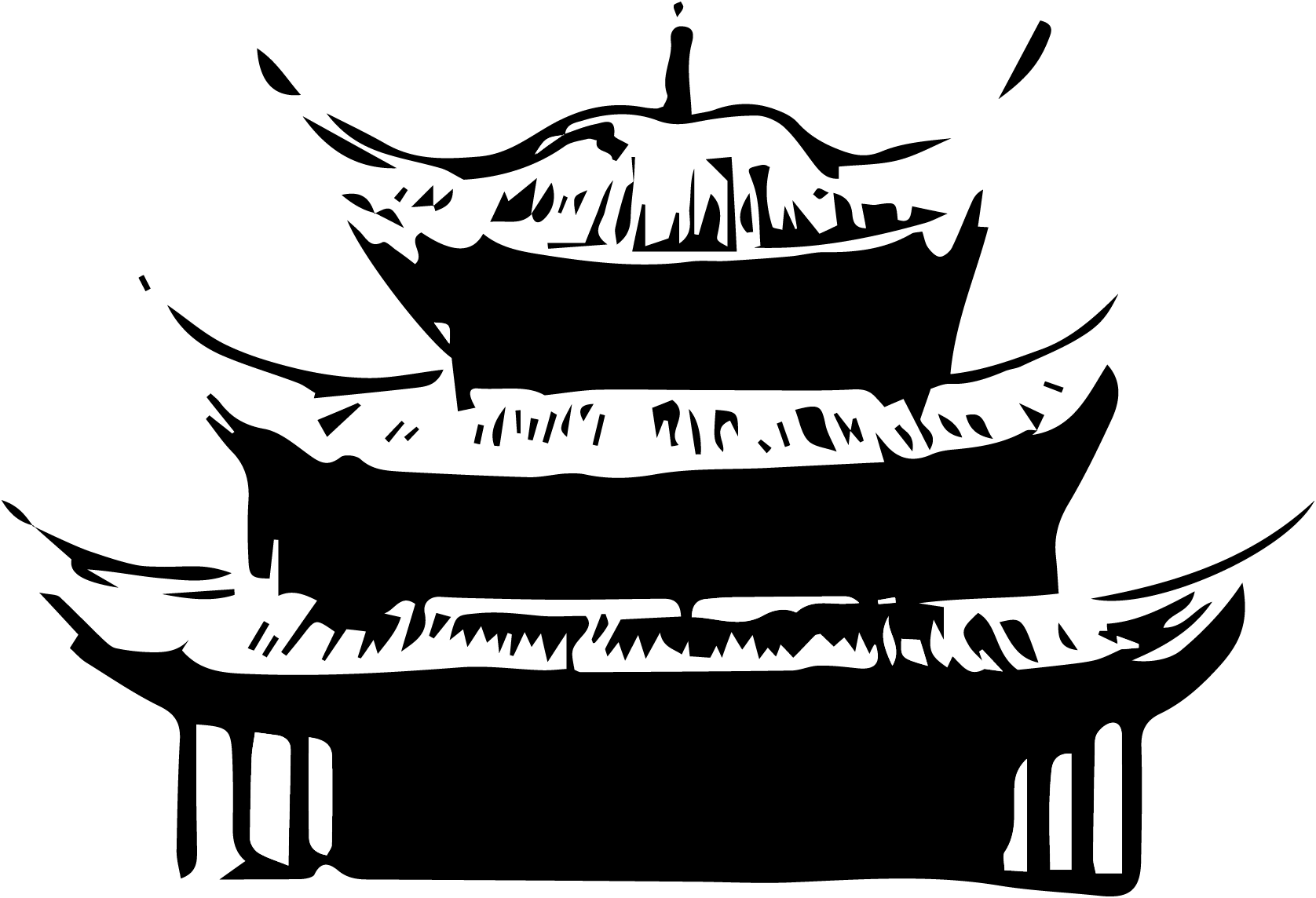Architecture on the Road
TRAVEL TIPS FOR VISITING ANGKOR WAT IN SIEM REAP
Angkor Wat Archaeological Park is undoubtedly one of the most fascinating places in Asia, and the time we spent there was the most impressive highlight of our trip to Cambodia. And no wonder; there are few places in the world with a similar majesty, and we felt extremely lucky to have the chance to experience such a spectacular place.
It must be said that the site is massive, and there are a ton of interesting things to see.
In this article I’m a sharing a few guidelines, tips, and information about Khmer Architecture, how to plan a visit to Angkor Wat Archaeological Park, emphasizing which are the most beautiful temples, with the hope of helping future travelers to make the most out of their visit.

WHAT IS ANGKOR WAT?
A VERY BRIEF INTRODUCTION TO THIS LEGENDARY PLACE
The Angkor complex is the most important and highly visited site in Cambodia, and one of the most important religious places in Asia and in the whole world.
The complex, named in 1994 ‘Angkor Wat Archaeological Park,’ spans an area of over 400 km and hosts hundreds of Hindu and Buddhist temples built from the 9th to the 14th century. The most famous, Angkor Wat, is recognized as the largest religious building in the World.
The temples were almost all built during the Khmer empire (802 CE to 1431 CE), during which there was tolerance of various cults within the kingdom.
The site was located around the city of Agkor Thom, the ancient capital of the Khmer Empire, of which today only the perimeter walls with the majestic entrances and some of the temples remain.
City walls, city gates, and the religious buildings were designed to last over time, and therefore built with durable materials (in this case sandstone and laterite, and rarely bricks, which require much more work and effort, but allows buildings to last for centuries).
For this reason, only the religious buildings of Angkor have survived to the present day. The buildings and houses of ordinary people, mostly made of wood, have been lost over time.
With the fall of the Khmer empire in the 15th century, the ancient capital and its places of worship progressively became depopulated, then ignored, then partially forgotten, and after centuries it was essentially lost amongst the vegetation.
The temple of Angkor Wat always remained an active Buddhist temple and monastery for pilgrims, but most of the other temples, because of their progressive abandonment and total lack of maintenance, “disappeared” into the forest.
The tales of a legendary city in the jungle reached the ears of foreign archaeologists in the sixteenth century, but the place garnered popular attention thanks to the testimonies of foreign explorers and scholars, especially Europeans, in the second half of the nineteenth century. Especially during the French colonial period, the importance of the site of Angkor was understood, and the first studies, restoration projects, and protection programs of the archaeological site were implemented.
The restoration works utilized the anastylosis method (restoration technique in which the original pieces of a damaged building are put back together), but they suffered a setback in the late 1970’s during the Khmer Rouge rule and subsequent occupation of Vietnamese troops. The restoration projects would only restart significantly after 1989.
However it was not the civil war or the foreign occupations that caused the greatest damage to the archaeological complex. Some of the most serious damage was due to the stealing of artifacts throughout the nineteenth and twentieth centuries for sale on the black market.
In 1992, the Angkor Archaeological Park was included in the UNESCO World Heritage List, allowing the authorities a further control to preserve the archaeological site, with the help of appreciative foreign institutions (especially French and Japanese).
Since the early 1990s, the park has opened up its grounds to a growing number of international visitors, and it has seen exponential tourism growth, from a few thousand visitors a year in the beginning, and up to a few million in recent years.
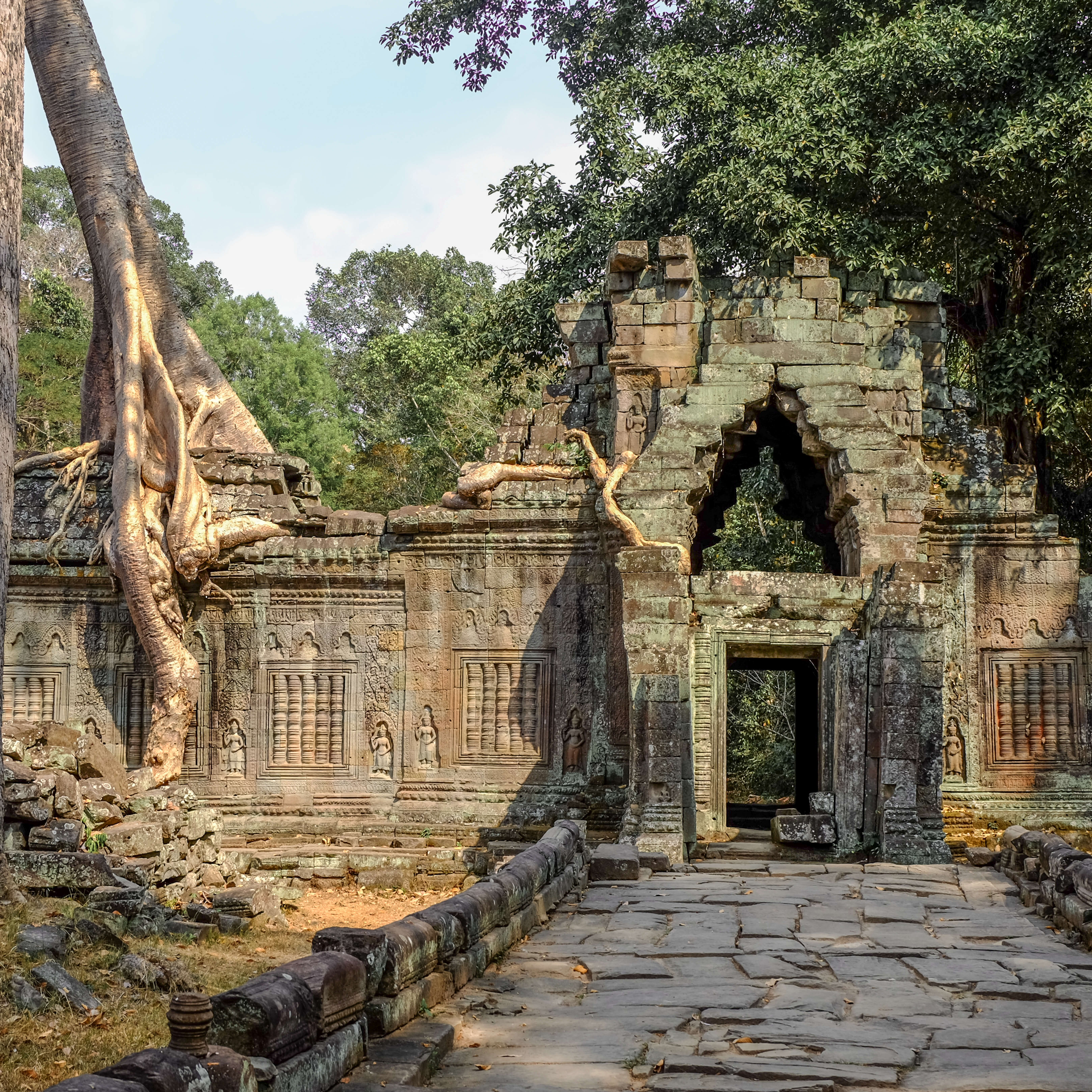
What you need to know to understand what you are visiting in Angkor Wat
The buildings that have reached us from the Angkor period are mainly religious, as these were the only buildings built with materials that lasted over time.
Visiting the Angkor temples, one can see many recurring elements, especially in the decorations, but there are many different styles which are named after the most important temple in that particular style.
Here I provide a quick list of the most common elements of classic Khmer Architecture, which is helpful to understand the various characteristics of the temples in Angkor Wat.
THE MOUNTAIN – TEMPLE
The “mountain-temple” is one of the most widespread and recurrent conformations in the classical Khmer places of worship.
The mountain in question, to which the temple is designed after, is Mount Meru, considered by both Hindu and Buddhist religions the center of the world/universe, as well as the place where the gods live according to the Hindus. The temples are architectural representations of this sacred mountain, with the central tower symbolizing the summit. Often this structure, which hosts the main sanctuary, is elevated on a higher terrace or on a stepped pyramid.
In the case of more important temples, the central tower can be surrounded by another 4 towers, always maintaining the square shape of the plan. The central tower is the most important and the one with the finest decorations. Here is located the central sanctuary, where is placed the effigy or representation of the worshipped deity. This room is often just a few square meters in size, as it is not open to religious services and ordinary people.
The concentric enclosures and the galleries around the central towers represent the base of Mount Meru and the mountains chains around it, while the moat that encloses the largest temples represents the ocean.
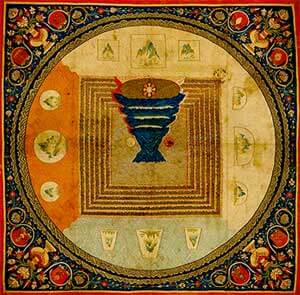
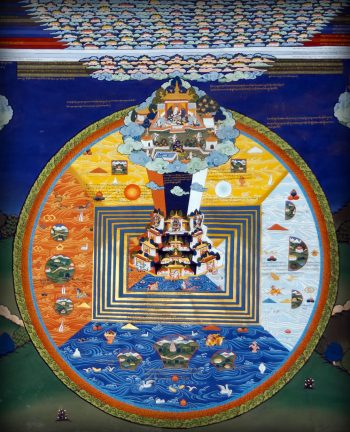
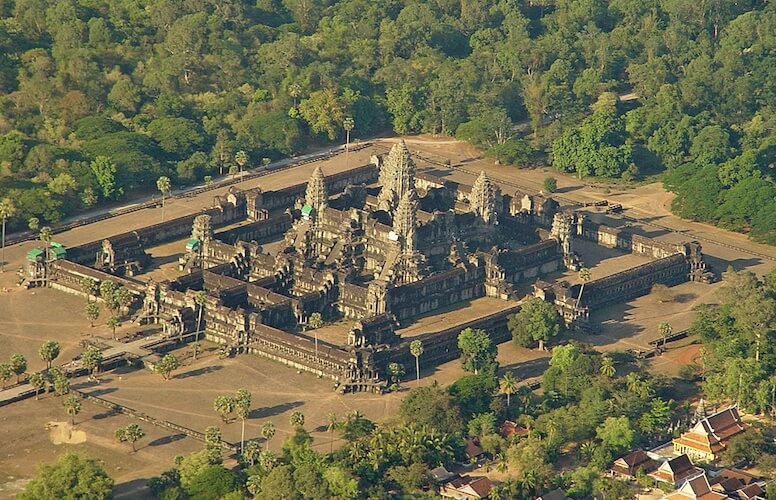
APSARA AND DEVATA
Walls and columns of the temples in Angkor are populated by graceful ladies, often dancing and smiling to pilgrims and visitors. These figures are Apsaras end Devatas, mythological creatures sent from the Heavens to delight Gods and Kings.
Apsara are usually dancing, while Devatas are standing in groups or alone, almost always elegantly dressed.
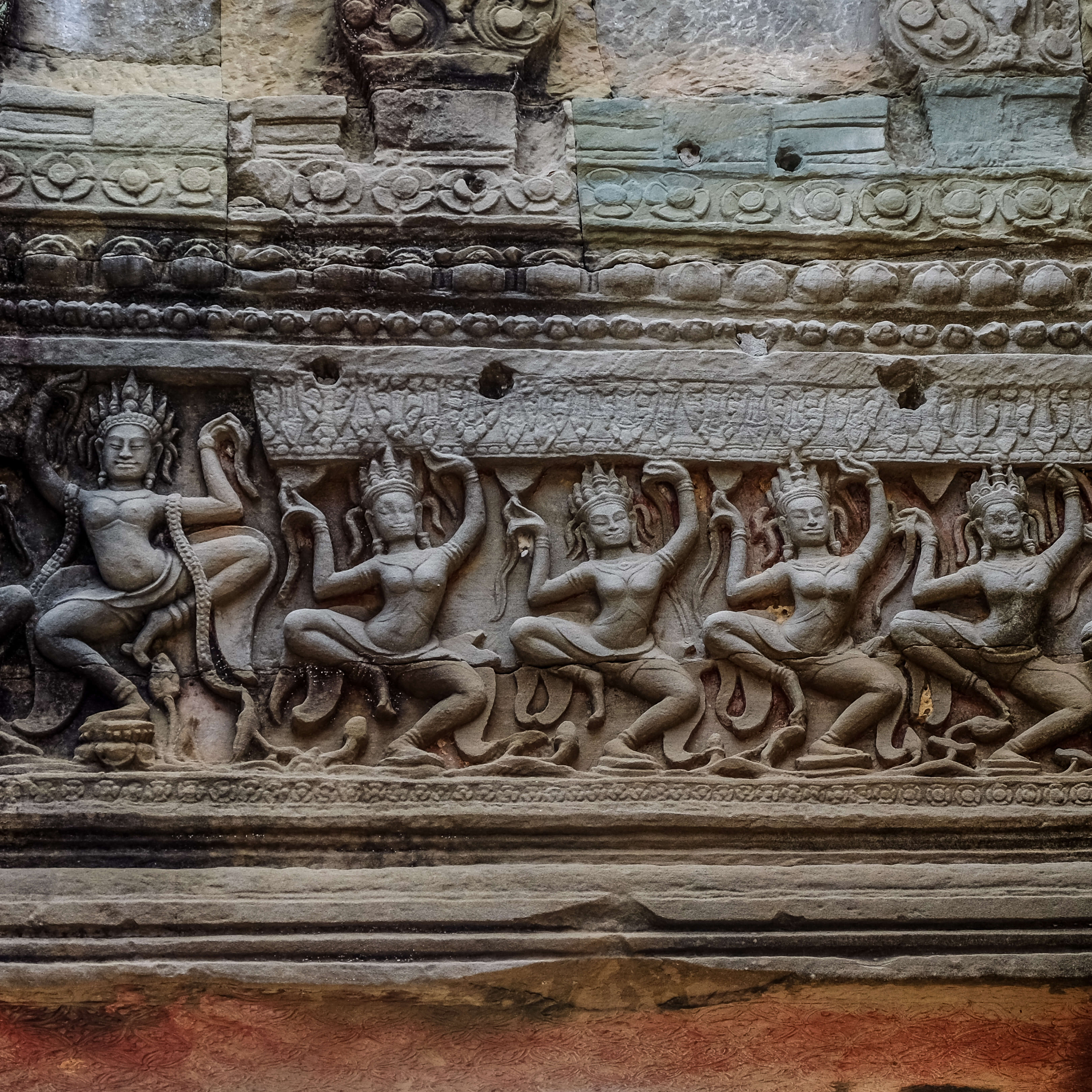
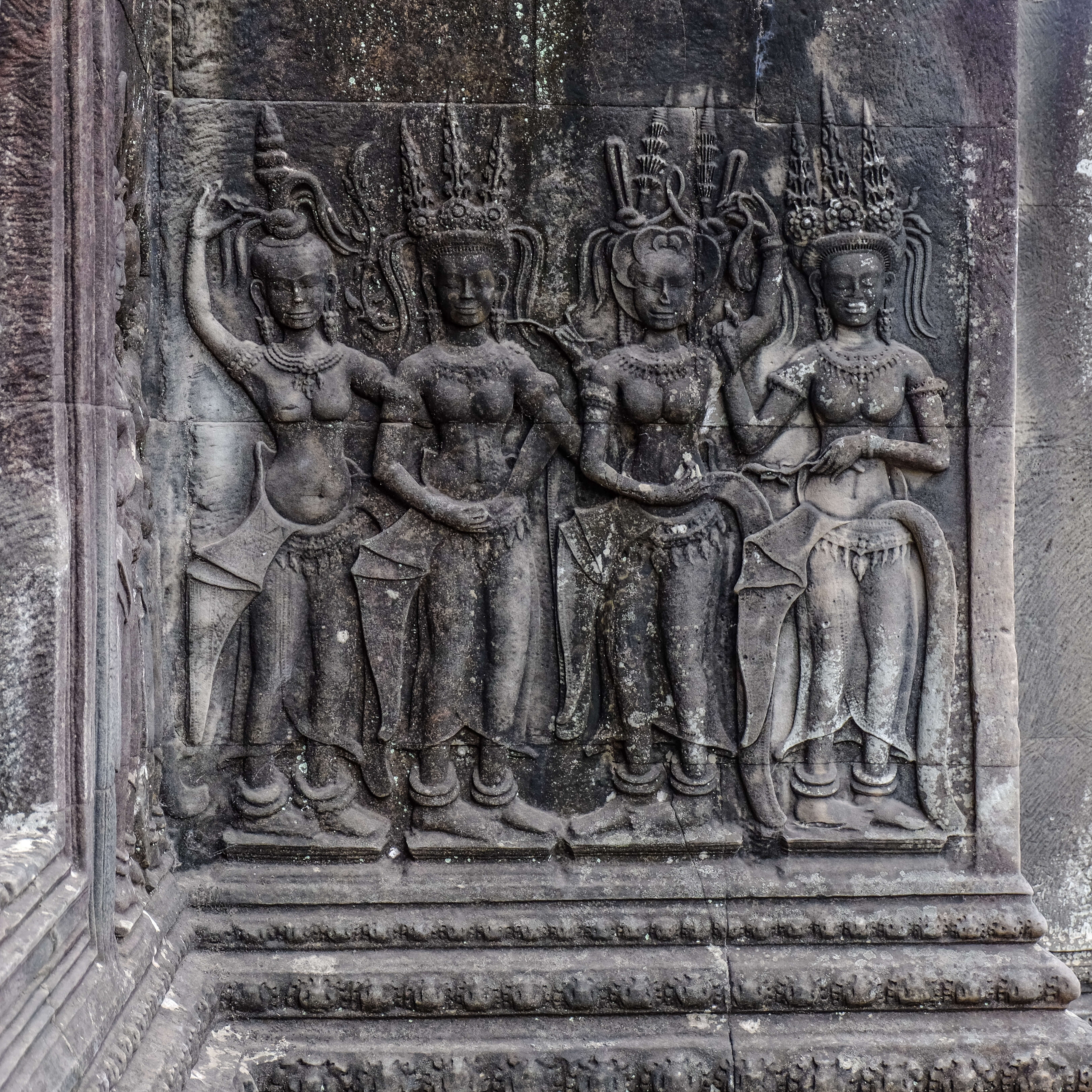
DVARAPALA
Usually placed around gates, Dvarpalas are human or supernatural guardians. They are often portrayed with fierce and frightening expressions, brandishing weapons like swords and maces.
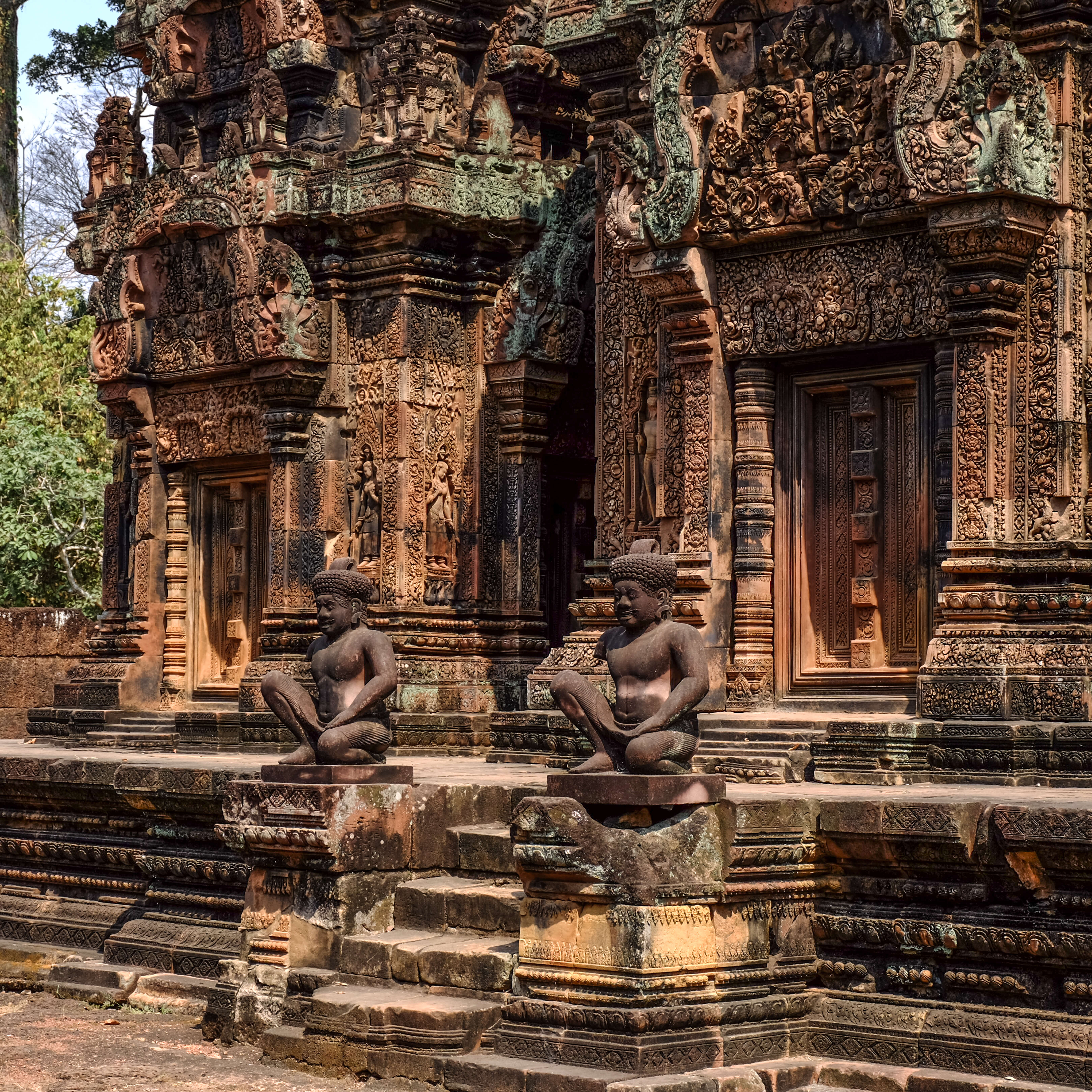
BLIND DOORS AND WINDOWS
In almost all the sanctuaries there is only one entrance door. However, there are blind doors positioned on the walls, for the pure sake of balancing the symmetry and appearance of the building.
Blind windows are often used purely for decorative purposes on walls that, without real openings, would otherwise remain empty and unadorned.
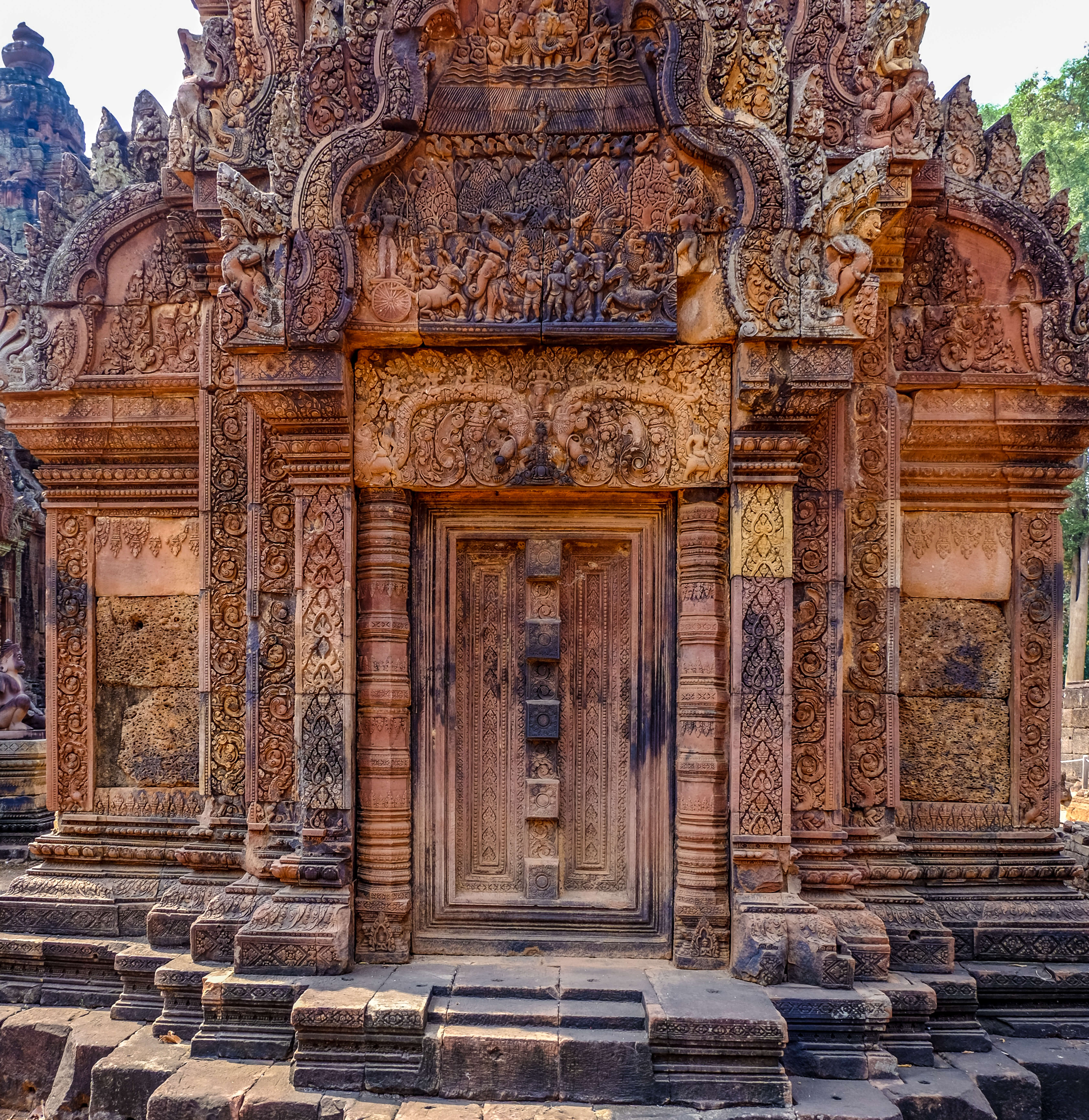
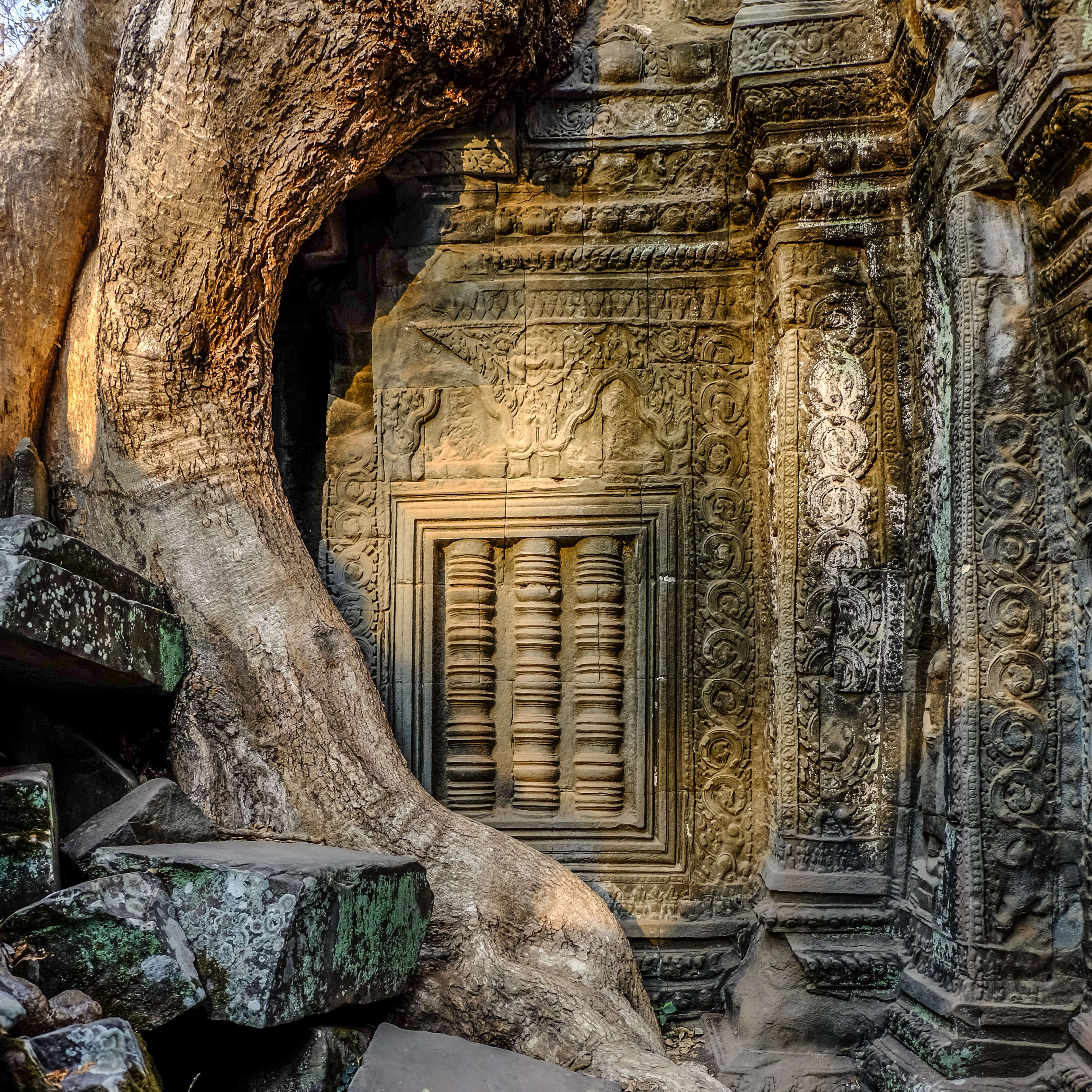
GOPURA
A Gopura is an entrance gate through an enclosure, especially used to enter temples and religious places. Temples can have several gopuras along their enclosures, each of them usually located at the cardinal points.
Gopuras can be richly decorated with statues and figures. Some of the most iconic gopuras in Angor Wat are characterized by the smiling Bayon face.
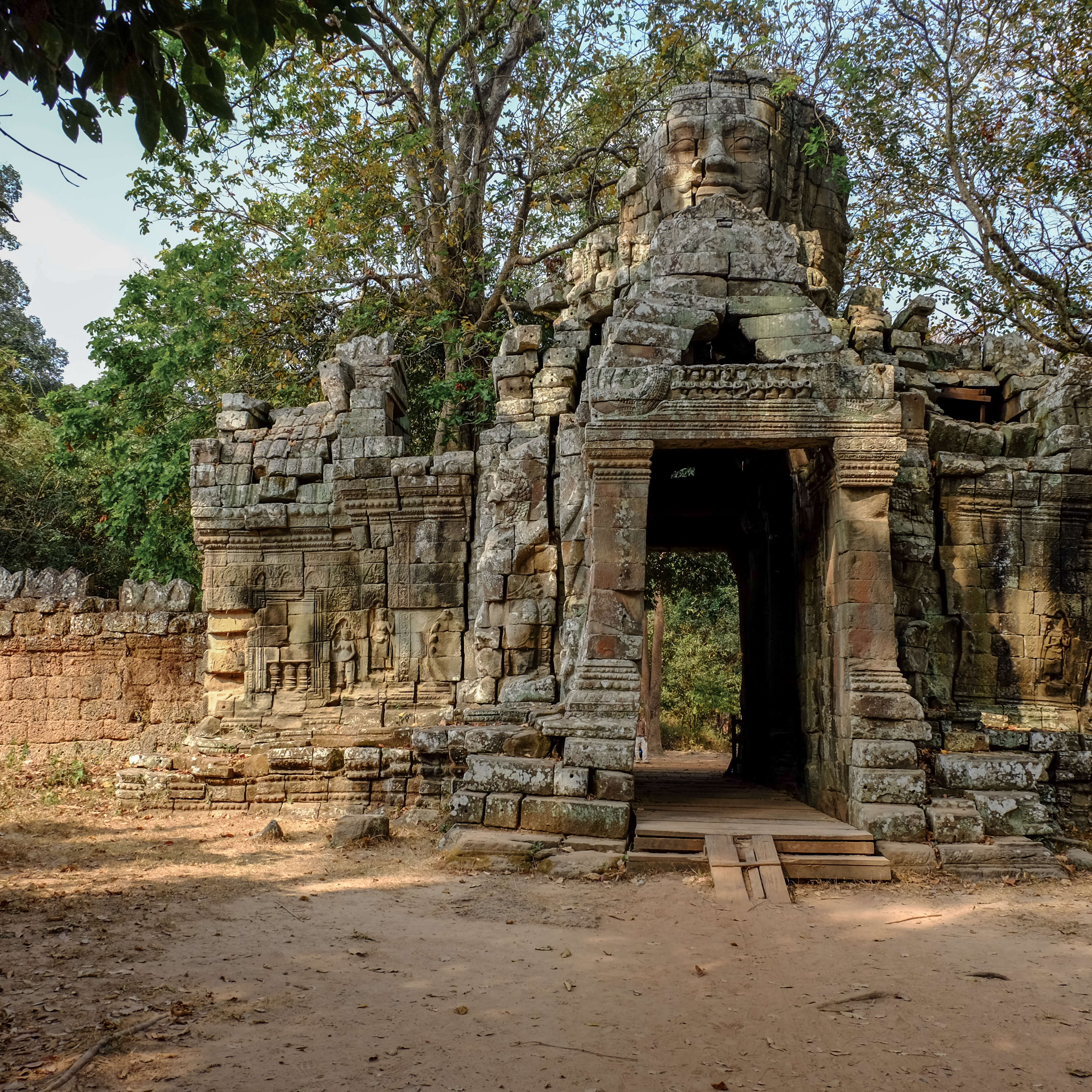
NAGA
Nagas are mythological characters that appear all throughout many Asian cultures. The word ‘Naga’ derives from Sanskrit’s “snake,” an animal which holds much symbolic meaning. These mythic creatures are commonly seen in Hinduism and Buddhism, and are very often represented in temples and important sites related to these religions.
These reptile beings are divine, or semi-divine, creatures closely connected to the water element. They often boast magic powers, and are usually represented in 3 forms: snakes, such as cobras or pitons, with multiple heads; half-human, half-snake beings; and humans with snakes attached to their heads or neck.
Nagas are especially dear to Cambodian culture, as Cambodians consider themselves: “born from Nagas.” The legend says that the Khmer people were born from the marriage between the King of Ancient Cambodia and the daughter of the King of the Naga People.
In Cambodia, Nagas are often appear as odd-headed statues (usually 5 or 7), abundantly adorning balustrades, staircases, bridges and gates.

HOW TO GET TO ANGKOR WAT
The city of Siem Reap is the main access point to visit the Angkor Wat Archaeological Park.
The site is located about 5km north of Siem Reap, and easily accessible from the city center by private vehicle.
It is not possible to visit Angkor Wat by public transport, and it is necessary to have a private vehicle; the most common are tuktuks or bikes.
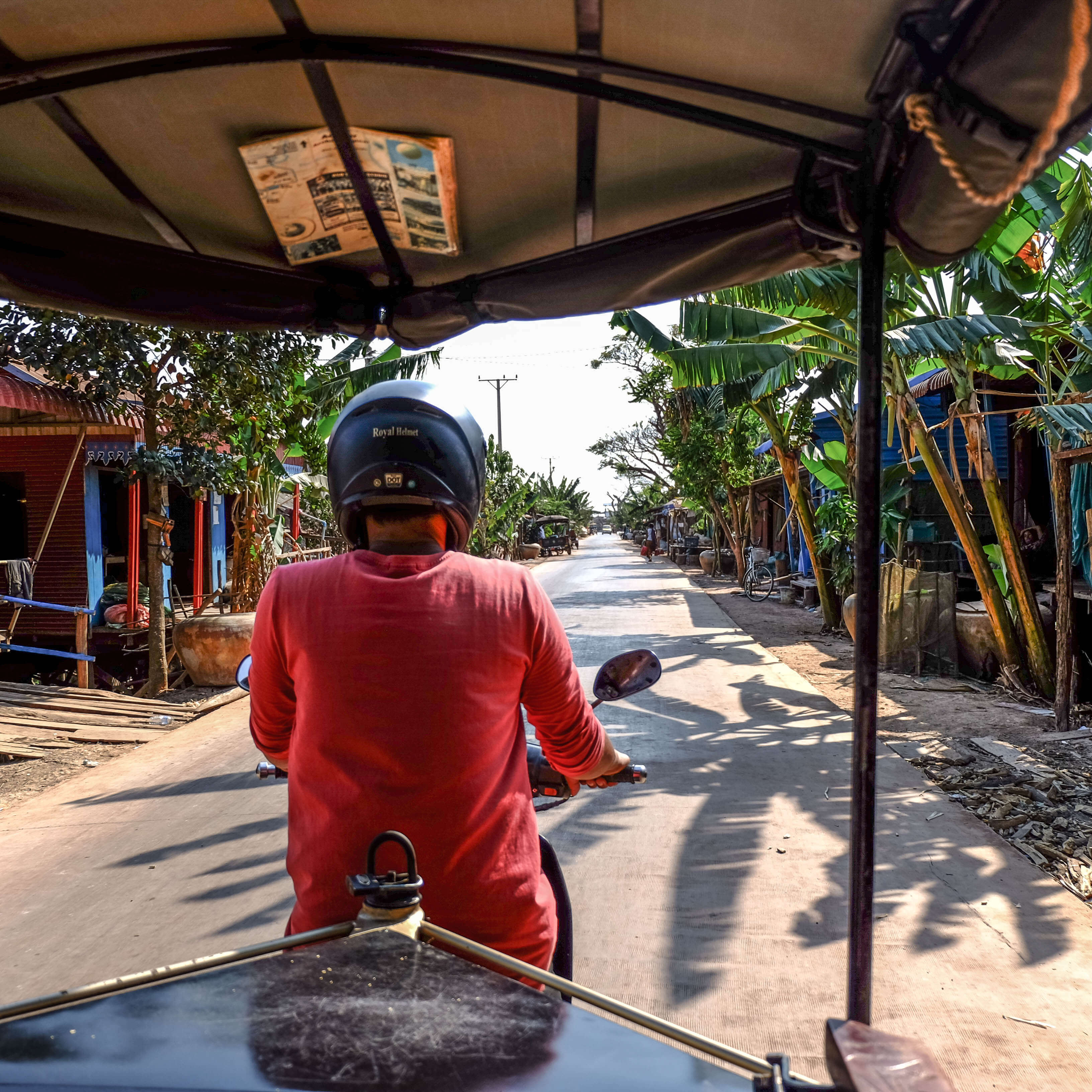
HIRING A TUKTUK DRIVER
Most tourists opt to hire a tuktuk driver for an agreed number of hours (around 15-20 dollars/day), who drops the visitor on and off at the entrance of the temples and waits for them at the other side.
This option is highly recommended for those who want to relax during their experience. Climbing up and down the temples in the midday sun can be exhausting, so enjoying a ride in the shade of the tuktuk can be quite pleasing and relaxing between one site and the other.
RENTING A SCOOTER OR A BIKE
It is now possible for visitors to drive their own transport inside the park, such as scooters or bikes, with rental services being offered by hotels and several rental shops in the city center.
This allows total freedom of choosing the route, taking the desired time, and leaving the park at some point to come back later, and so on so forth.
For these reasons, we opted to rent our own transport method, signing up for a motorbike at our guesthouse.
It must be said that Angkor Wat Park is massive, and the distance between each temples is several kilometers, not to mention the extremely hot climate. Driving around was surely a more tiring thing to do than to be carted around by a tuktuk, but the park is such a wonderful place to drive that we enjoyed every minute of it and we were very happy with our choice.

The only ticket office is located on Charles de Gaulle Street about 4 km from the center of Siem Reap, and is open from 5am to 5.30pm.
There are 3 types of tickets available for visiting Angkor Wat Archaeological Park:
• 1 day pass $37
• 3 day pass $62
• 7 days pass $72
The 3-day pass is valid for 10 days from the time of purchase, and the 7-day pass is valid for 30 days from the time of purchase. Withing the validity period, the visiting days don’t have to be consecutive
For daily entry into the park, the ticket will be punched, and from that moment you can enter and exit the park indefinitely during the same day.
For example, we decided to visit Angok Wat at dawn, then around lunchtime we left the park to hide from the heat, to then return in the afternoon. In this case, it is not necessary to stamp the ticket again as the morning entry is still valid.
The ticket is personal and not transferable. In fact, the photo of the owner will be printed on it (taken at the moment of purchasing), and will be checked at every entrance-check-in point.
It is possible to pay for the ticket with foreign credit cards, and in any case, there are ATMs at the ticket office.
Tickets issued before 5pm are valid for the same day. Tickets bought after 5pm are valid from the day after.
Thanks to this trick, it is possible to buy the ticket for the following day in the late afternoon, but still enter the park the same day after 5.30 (after this time, the checkpoints stop working), and enjoy the sunset at some temple for free.
Not all the temples in Angkor Wat Archaeological Park have the same opening time. Most of the temples however, are open from 7.30 am to 5.30 pm.
Angkor Wat temple opens at 5am to allow visitors to experience its magical sunrise.
Phnom Bakheng and Pre Rup are open from 5 am to 7pm because their pyramid shape offers a wonderful opportunity to enjoy both sunrise and sunset from the top of their “mountain”.
It is a good strategy to plan a circuitous route to visit the temples and decide at approximately what time of the day to arrive at each site to make the most out of the experience.
We found ourselves in pole position at 7.30 am at the entrance of Ta Prohm, one of the temples I was most eager to visit, and it turned out to be the best choice. Being there at the opening time made it possible to be among the first to enter and enjoy the temple devoid of other visitors.
About 30 minutes after a few tour buses with a hundred tourists arrived, and you can imagine how the peaceful, silent and mysterious atmosphere has suddenly changed.
Around sunset, most of the tourists rush to one of the pyramid temples (such as Phnom Bakheng and Pre Rup) to see the sun setting over the jungle. On the contrary, we found ourselves driving in a counter direction, visiting some of the smaller temples we found along the way, immersed in silence and the warm glow of the sunset. We were the only ones visiting the temples, granting a truly magical experience.
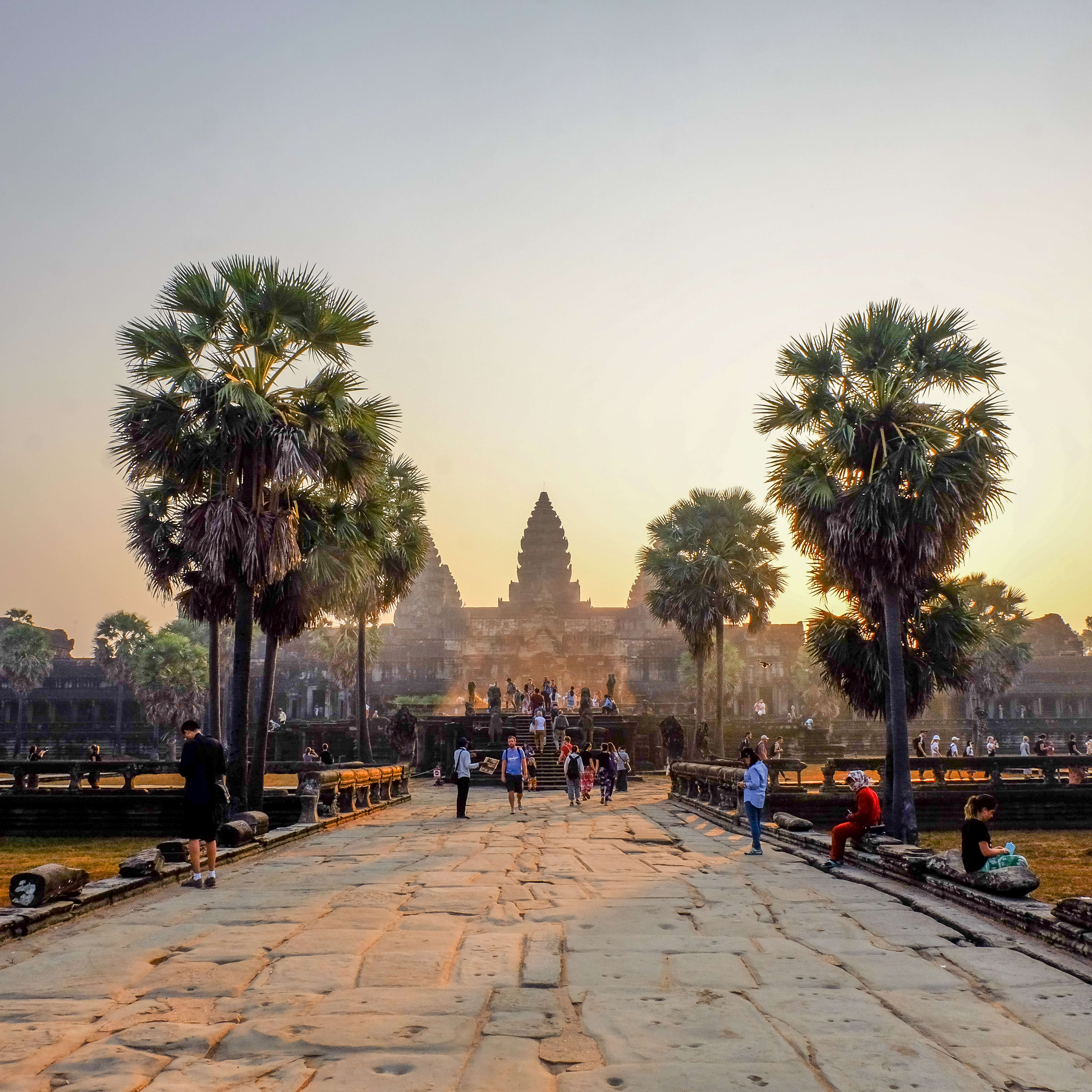
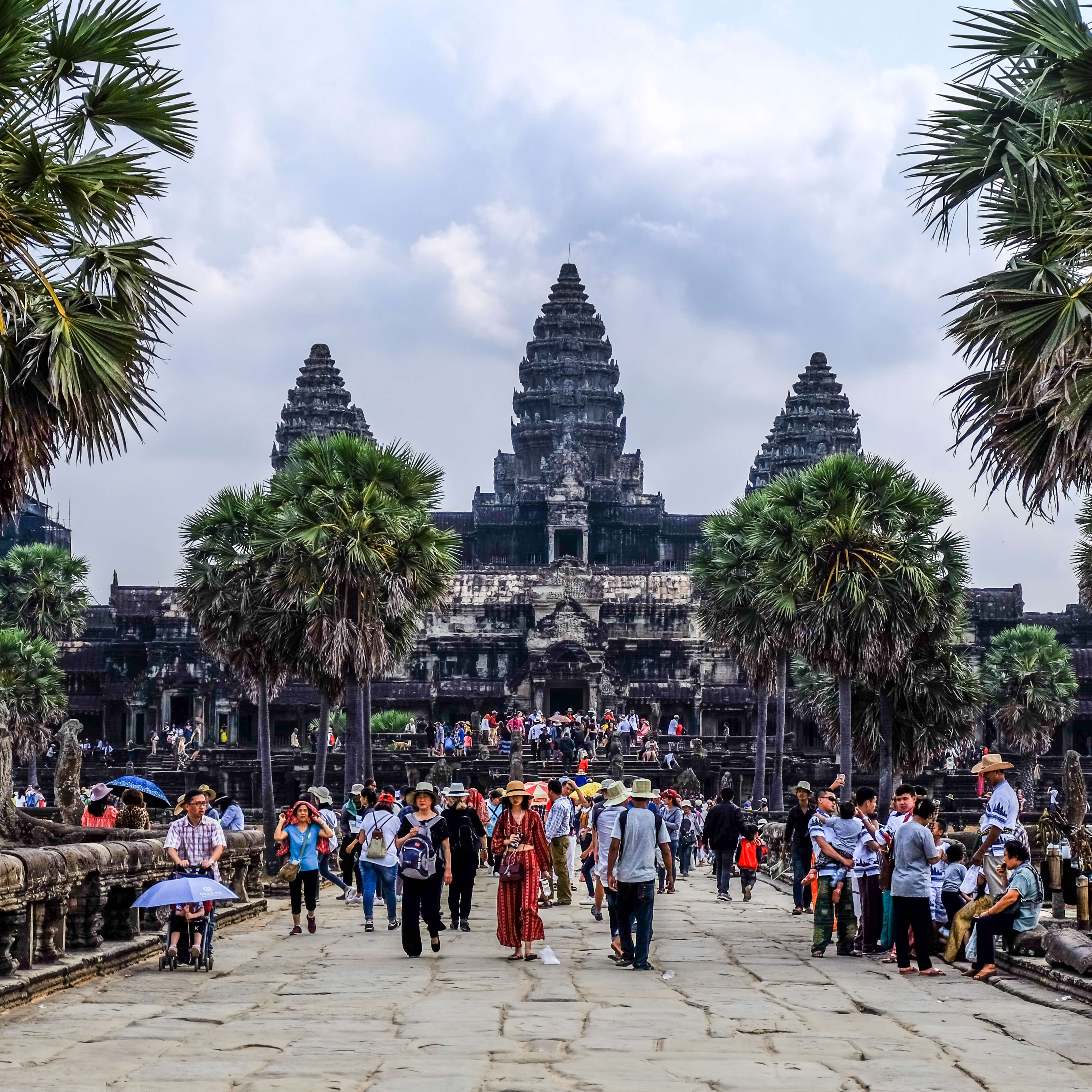
Inside Angkor Wat Archaeological Park there are dozens of temples, and visiting all of them will require a huge amount of time and energy.
It is therefore important to get an idea of which temples are appealing to you during your visit so you can plan a rough itinerary to make the most of them.
There are two main circuits inside Angkor Wat Archaeological Park: the “Small Circuit” of 17 km and the “Grand Circuit,” which is a 26 km loop extension of the Small Circuit.
The Small Circuit can be done in 1 full day, while the Grand Circuit requires more time.
We spent 2.5 tiring, but extremely beautiful days in the main Angkor area, and a part of the third day to reach the temple of Banteay Srei, located 1 hour drive north from Angkor Wat, and totally worth the time and the effort to go there.
If you have particular photographic needs, it can also be a good practice to plan visits based on the time of day. In fact, some temples are especially famous for their sunset, and therefore they are much more crowded in the late afternoon. Angkor Wat is especially famous for its beauty during sunrise, so be prepared to share the show with a few hundred other people!
Being ready at the entrance of a specific temple at the time of it’s opening can be a smart move to enjoy it while still sleepy and almost empty. Meanwhile, from late morning through early afternoon, almost all the major temples are really crowded, and the hot temperatures make the visit a bit more challenging.
To get an idea of which temple to visit to enjoy the best sunset, you can consult the Angkor Sunset Finder .
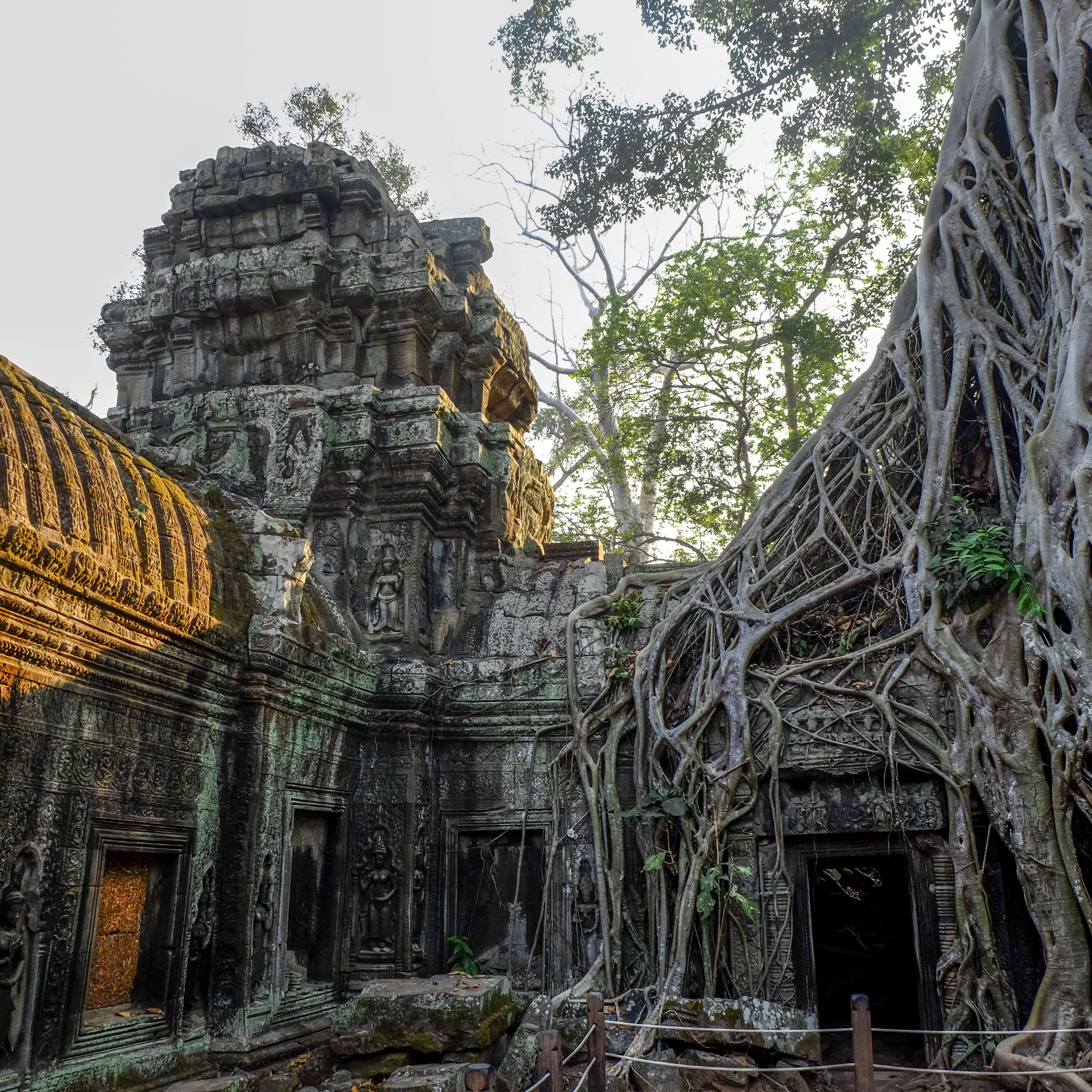
Angkor Wat is the park’s most famous temple and is considered the largest religious building in the World, representing the ultimate expression of Khmer Art and Architecture.
Born as a Hindu temple, at the end of the 12th century it was converted into a Buddhist temple. Even after the fall of the Khmer Empire, the temple has never been totally abandoned like other major temples of the archaeological park, but it has remained a pilgrimage destination over the centuries.
It is a source of great national pride and it is no coincidence that a stylized figure appears on the Cambodian flag!
Angkor is the quintessential example of the mountain temple, with the central towers representing Mount Meru (the center of the universe for Hindus and Buddhists), the outer enclosures representing the mountains around it, and the moat symbolizing the ocean.
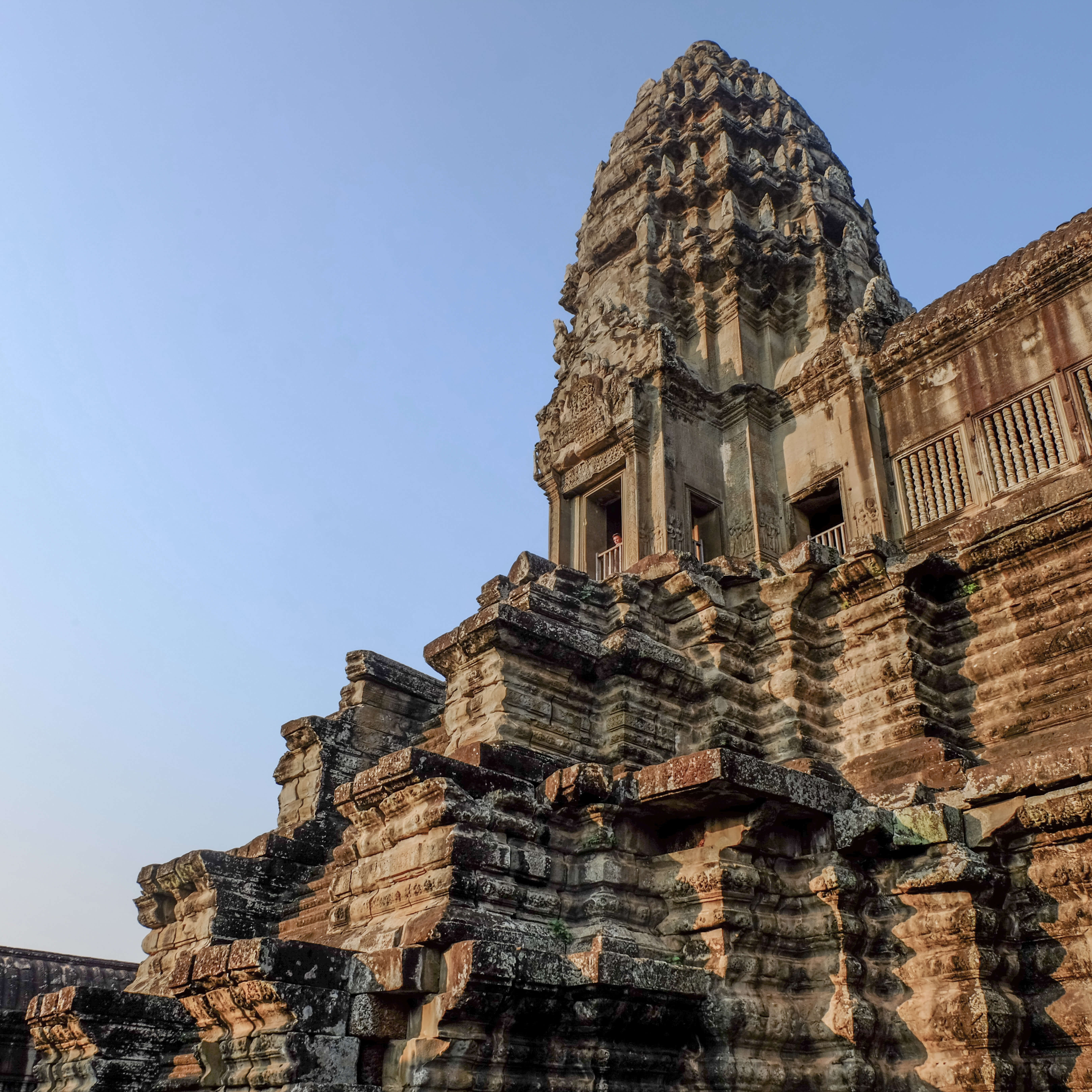
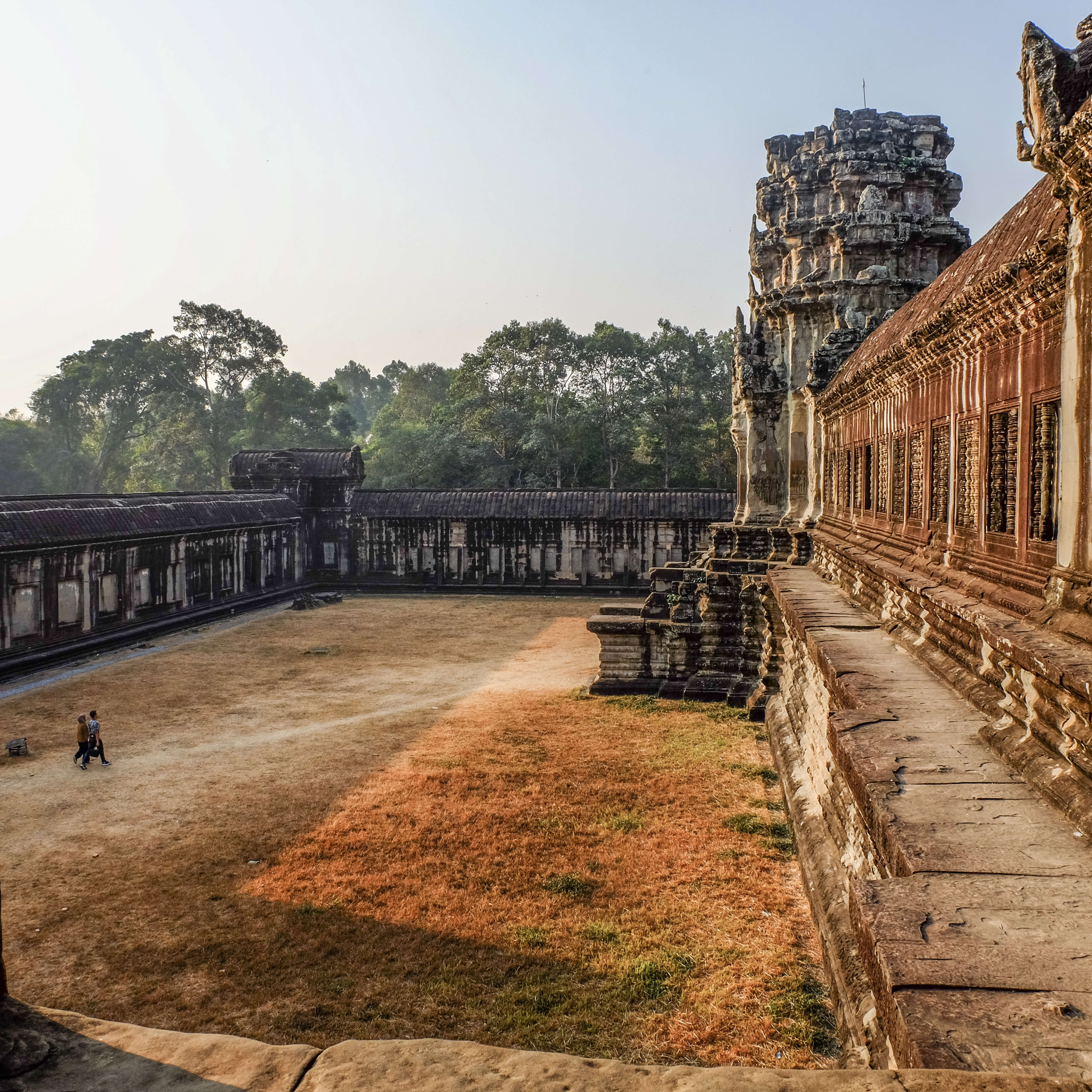

SUNRISE AT ANGKOR WAT: IS IT WORTH IT?
Angkor is especially famous for magical sunrises. This is why every day hundreds of visitors flock to this temple when it is still dark, and wait for the sun to rise (Angkor Wat opens at 5am for this reason).
But is it really worth it?
Visiting Angkor Wat at dawn can definitely be a good idea! The moment of dawn is very fast and extremely crowded, but intensely beautiful. However, after dawn, most tourists leave, and this is perhaps one of the best moments of the day to visit the temple!
As the crowds disperse, the soft light and the almost chilly temperature of the early morning fills the space, and the visit to the temple is really much more enjoyable than during the day!
We actually visited Angkor two times: the first time at 12pm, which we didn’t enjoy at all because of the extreme heat and crowd, and the second time at 6am, which was really lovely.
Plus, visiting Angkor so early in the morning allows you to be ready at 7.30 for the opening of other temples so you can enjoy them in a less crowded and more comfortable time of the day.
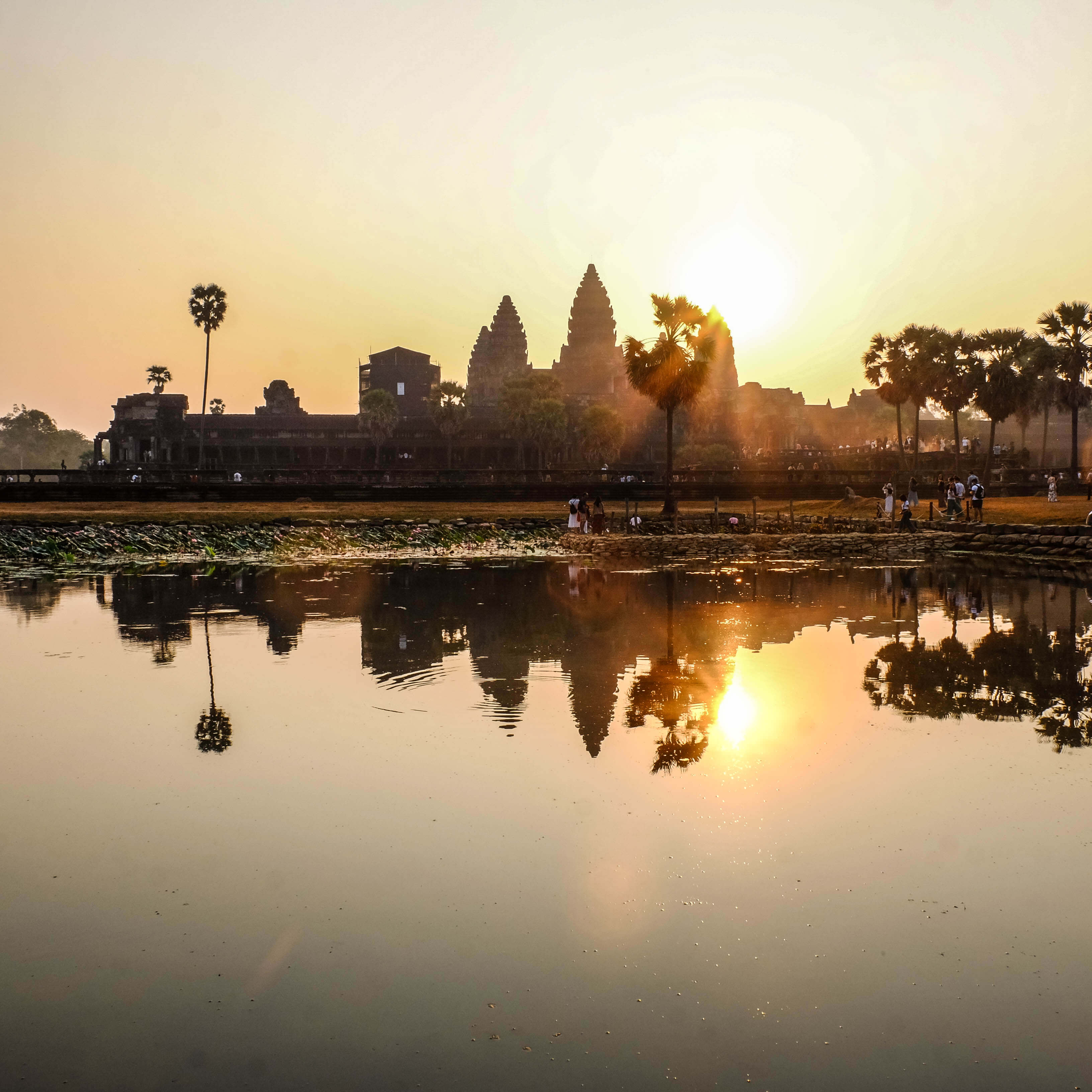
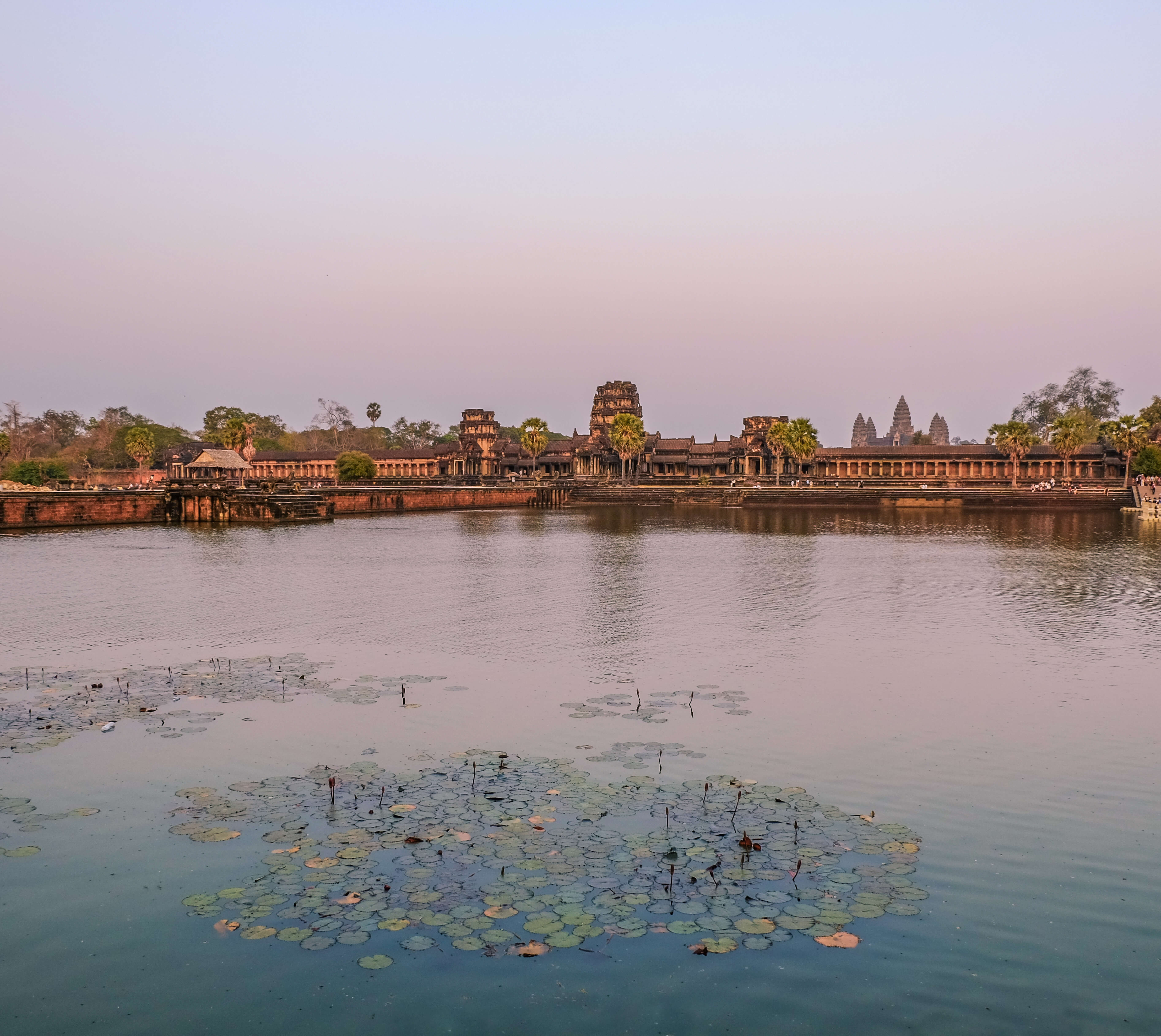
Angkor Thom (in Khmer “Big City”) is the last capital city of the Khmer Empire located in the Angkor Site.
Built at the end of the XII century, inside its city wall it used to host the King’s palace and the higher classes of society.
Today only the city walls Angkor Thom remain, with their impressive gopura gates and entrance bridges decorated with nagas, and a few scattered temples.
Among them, the most important is the Bayon temple, which is located in the middle of the city site.
The old King palace and the houses of the inhabitants have been lost long ago to time, as they were mainly built with wood, which is a perishable material. Today the site of the old Capital is mostly covered by the jungle.
Characterized by the multitude of smiling faces carved on all four sides of each tower, the mountain- temple Bayon is definetly one of the most beautiful and special temples of Angkor Wat Archaeological Park.
It is situated in the middle of Angkor Thom, as it was one of the most important buildings of the ancient Capital.
The smiling face are believed to be some representation of the King Jayavarman VII’s face due to the similarity of the Bayon’s faces with the statues of the King; although some other theories believe that they are representations of Avalokiteśvara, the bodhisattva of great compassion in the Mahāyāna Buddhism.
Regarded as “the most striking expression of the baroque style” in Khmer Architecture, the Bayon Temples gives the name to the “Bayon style“.
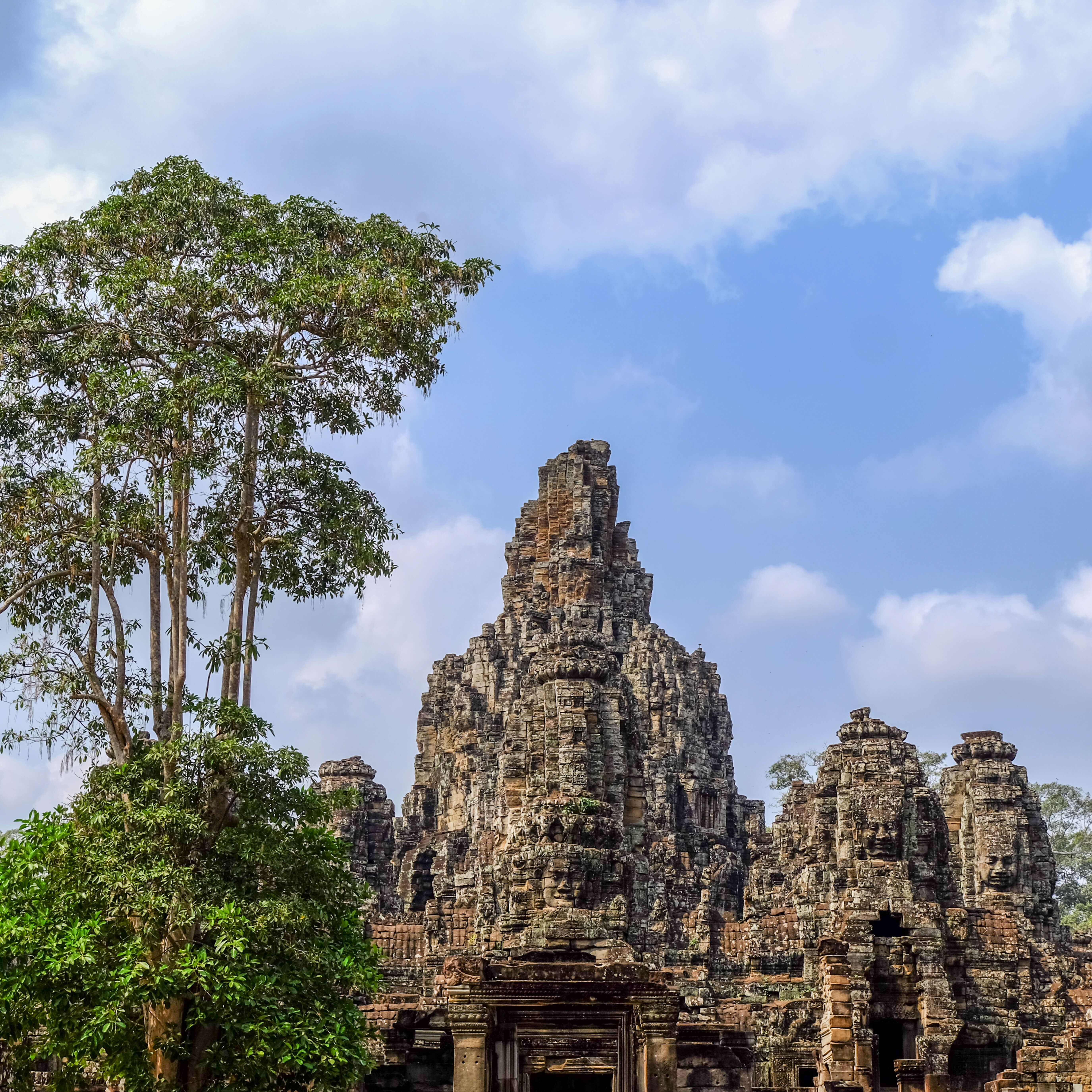
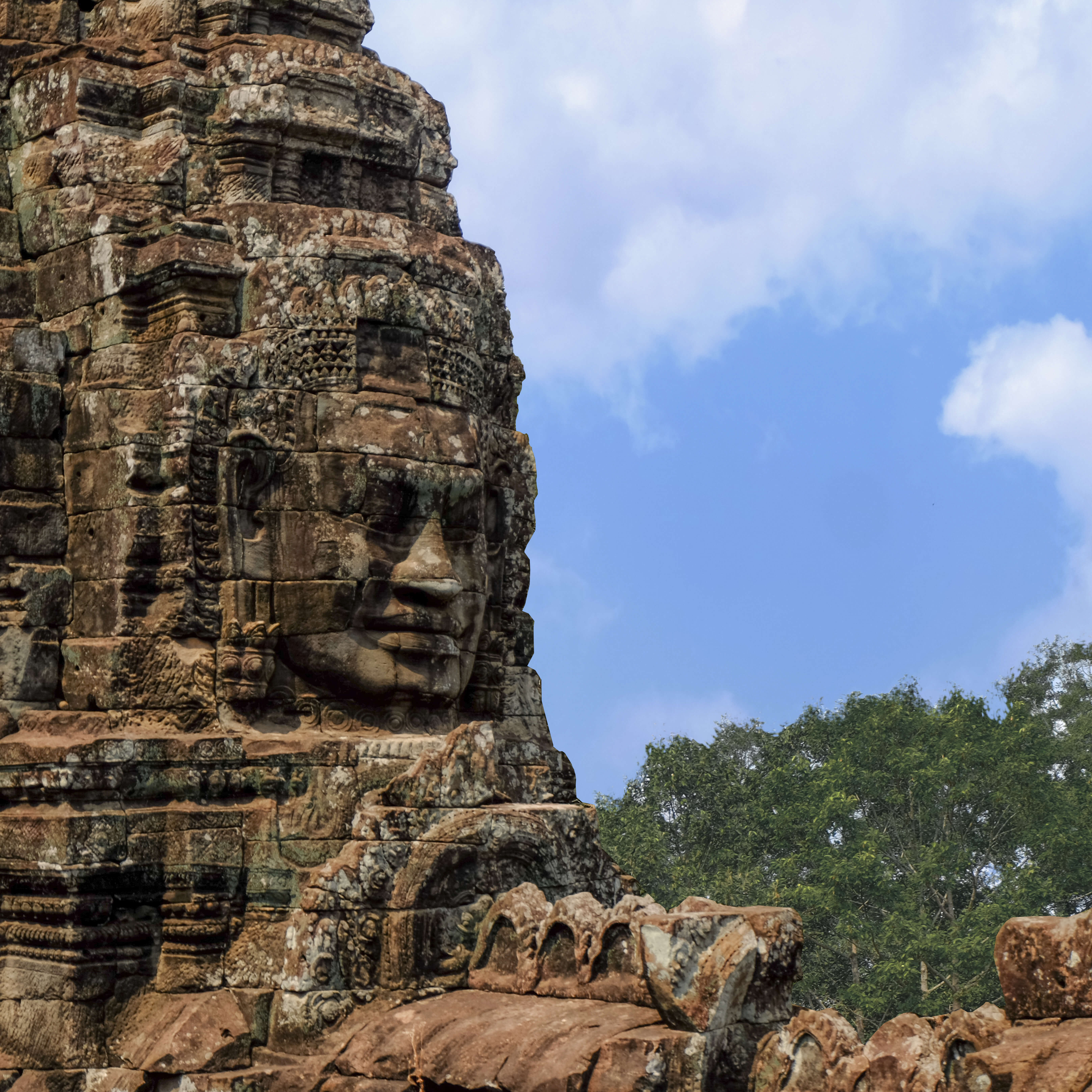
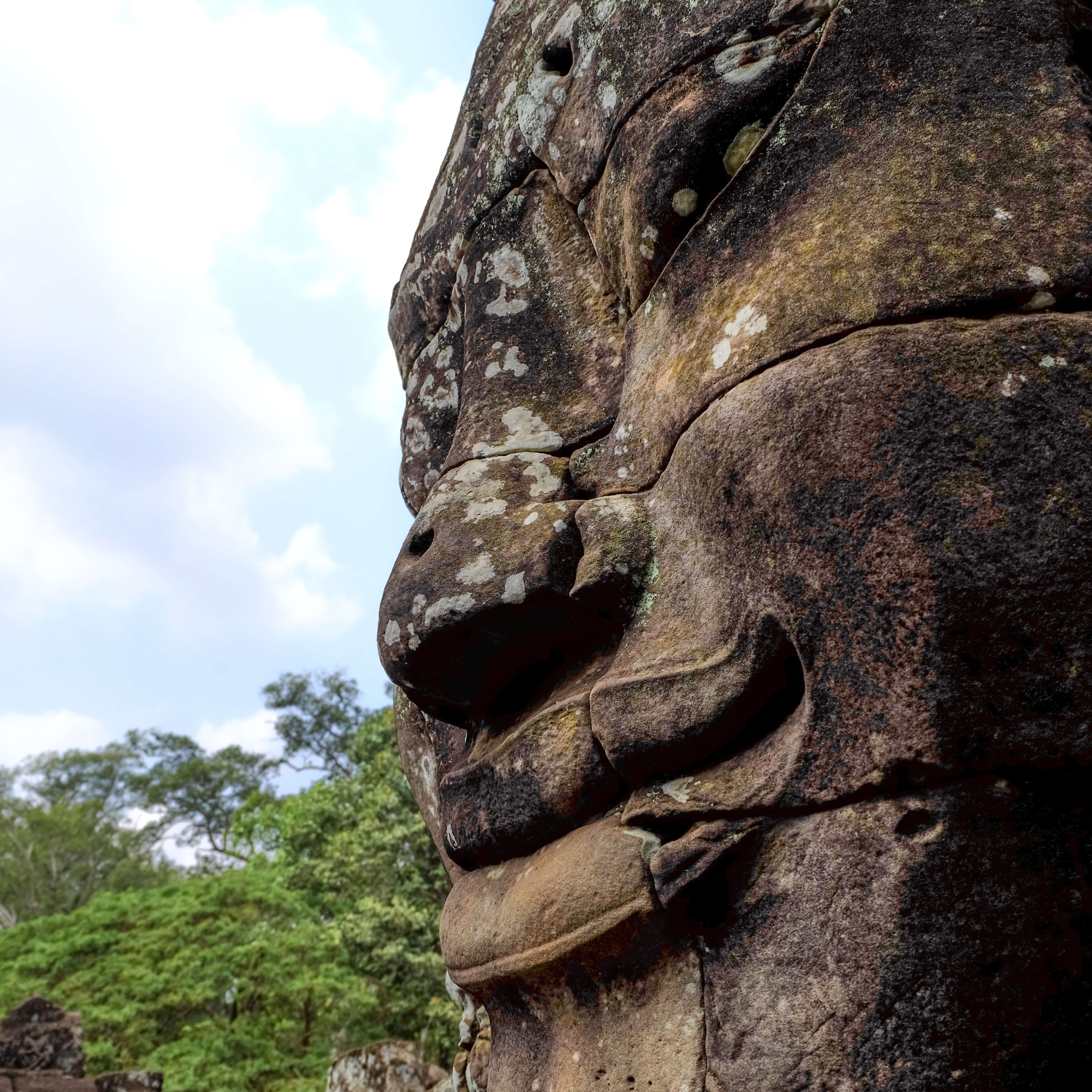
Built by King Jayavarman VII as a Mahayana Buddhist monastery and as a university, Ta Prom is one of the most famous and visited temples in Angkor Wat.
What makes Ta Prohm special is its picturesque coexistence with the surrounding nature and the deliberately unkempt appearance. The temple has in fact remained in the same condition in which it was found, by the choice of the restorers, who decided to preserve the atmosphere created by nature that for centuries has grown unrestrained over its ruins.
Ta Prohm was also featured in the Tomb Raider movie, which has further increased its popularity.



Located about 35km north of Angkor Wat, the small Hindu temple of Banteay Srei is considered a jewel of Khmer Art.
Dedicated to Shiva, its name means “Women Fortress,” and it is the only temple built not for a sovereign, but for a citizen.
Its main characteristic is the red color of its material (red sandstone), the small scale (almost a miniature compared to the temples of Agkor) and the beautiful and intricate decorations. The sandstone lends itself very well to it’s processing, complimenting bas-reliefs sculptures with their very fine details, many of which have come down to us in excellent condition.
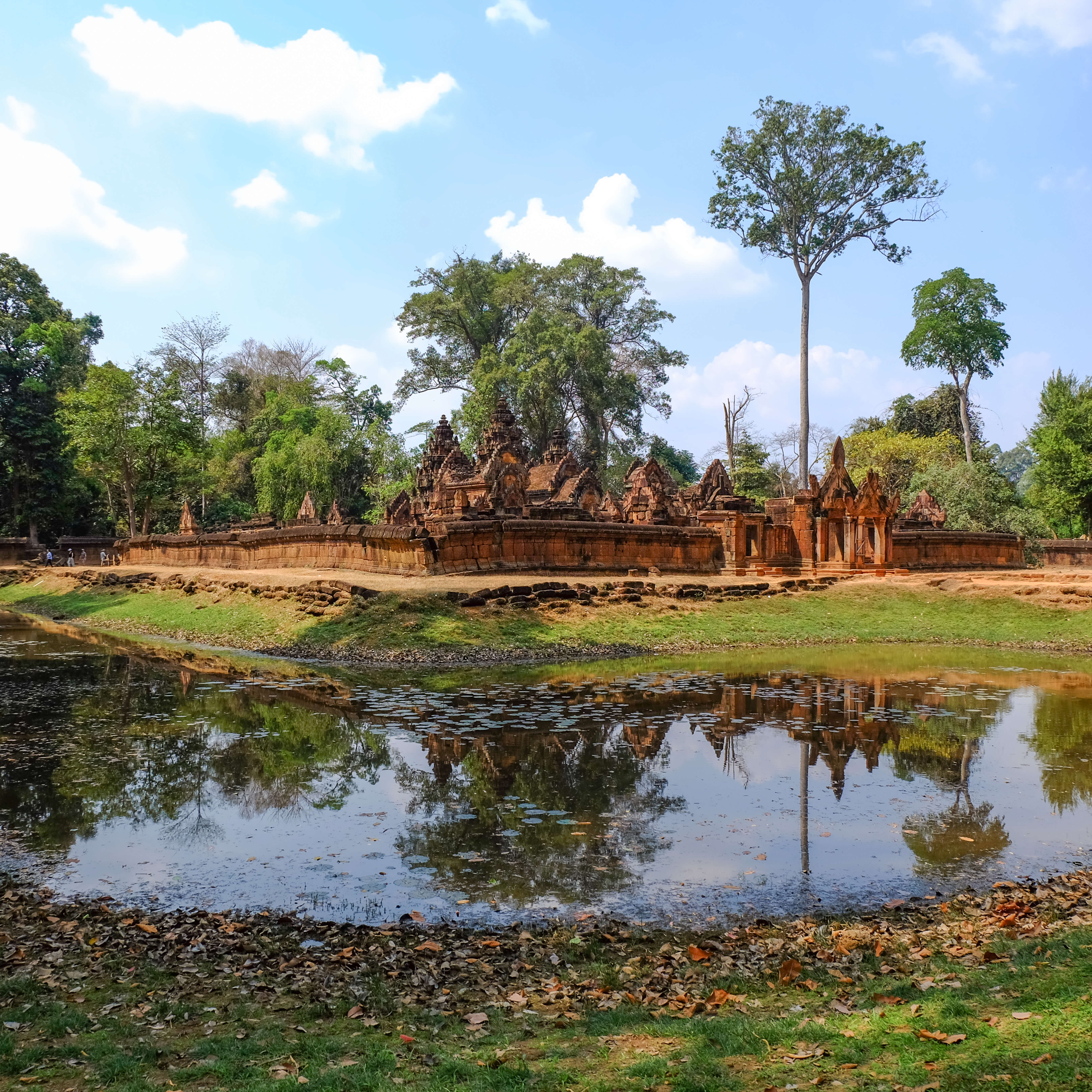
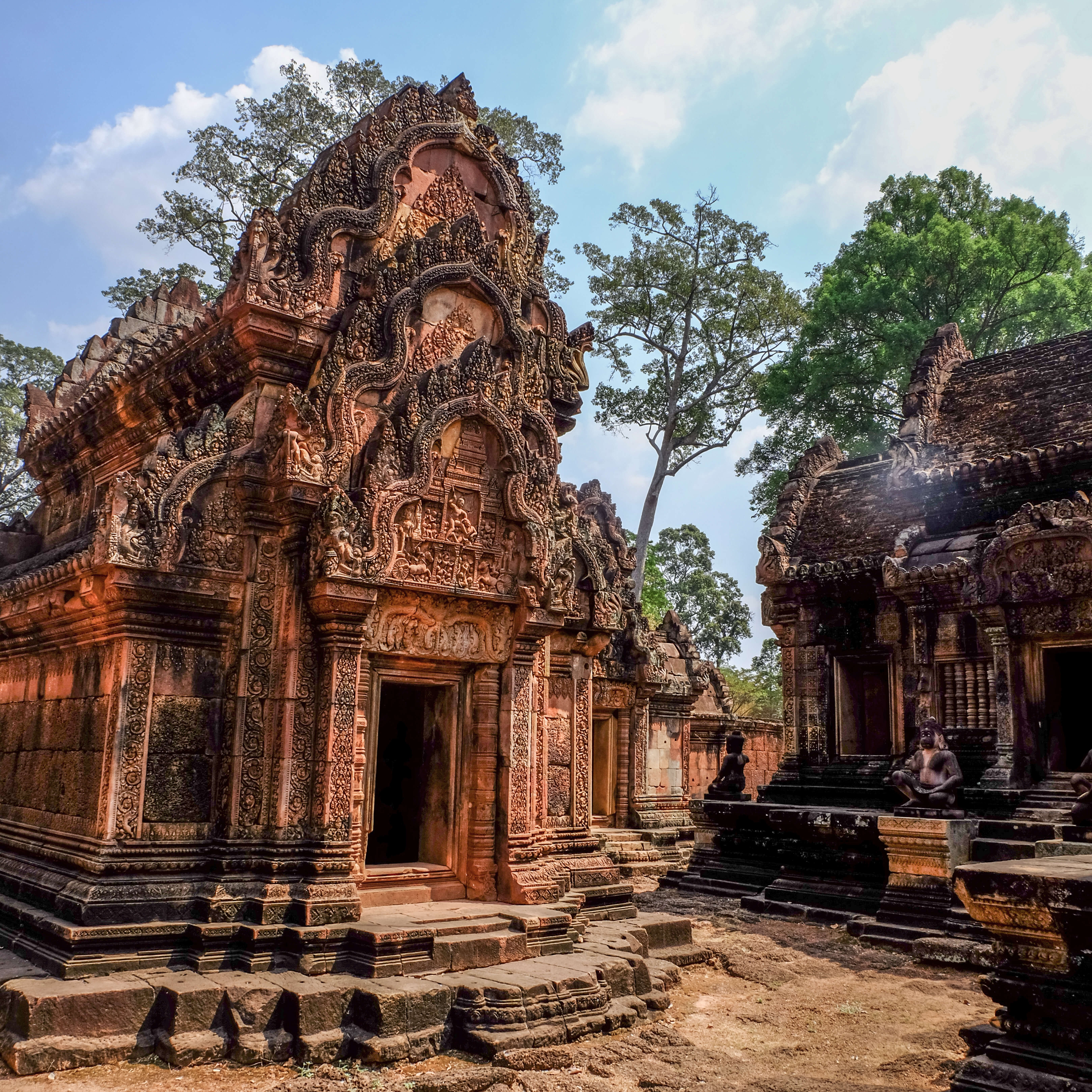

The location is quite far from the main center of Angkor Wat which makes this gem less visited by tourists short on time (the ride to reach the temple is about 1h).
However, the visit to Banteay Srei is especially recommended for those interested in admiring some local Cambodian architecture. The road to the temple passes through several beautiful local villages, and it is possible to admire many beautiful traditional countryside timber houses, and have a view of the local rural life.
The trip to this part of the countryside around Siem Reap is absolutely one of the moments we enjoyed the most when visiting Angkor Archaeological Park.
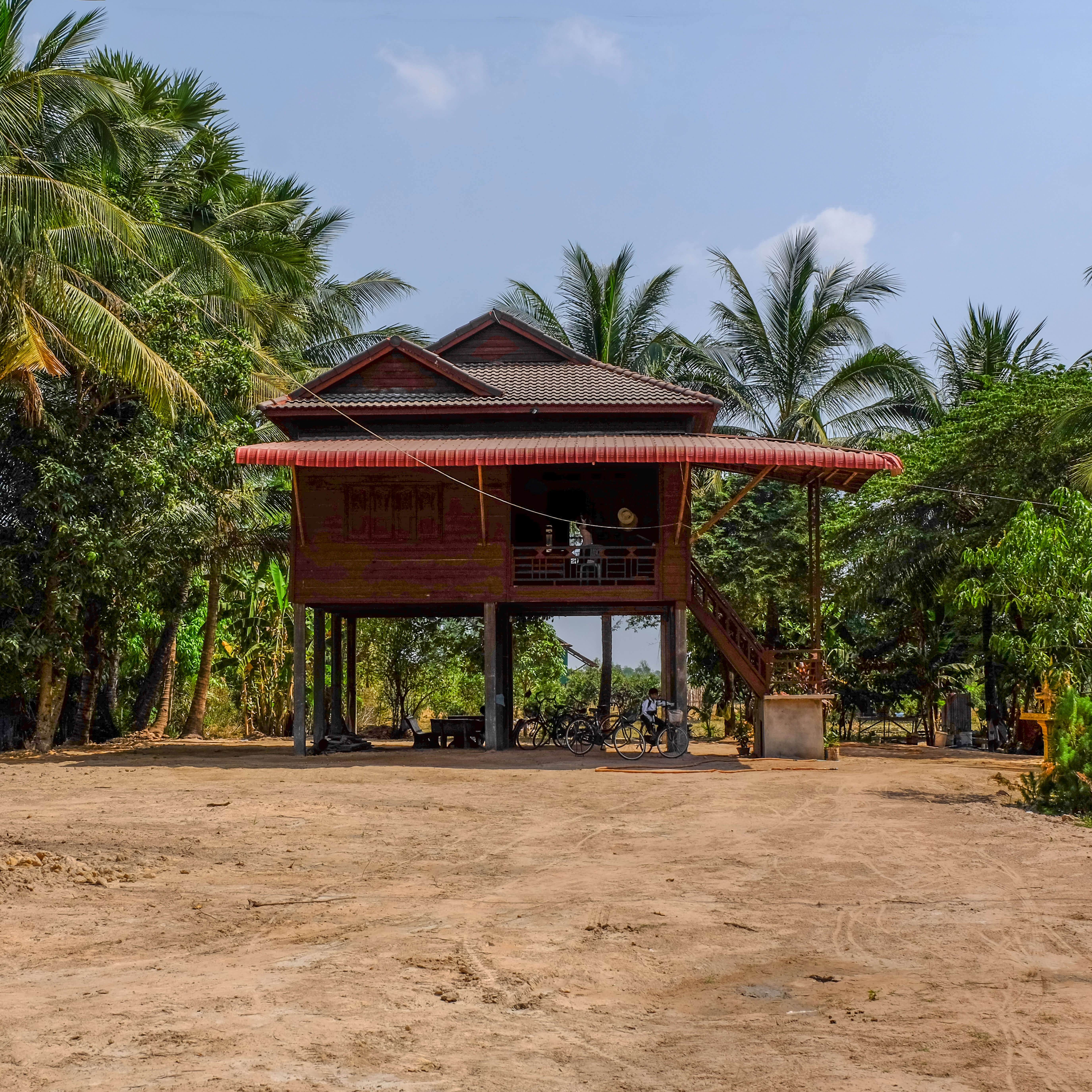
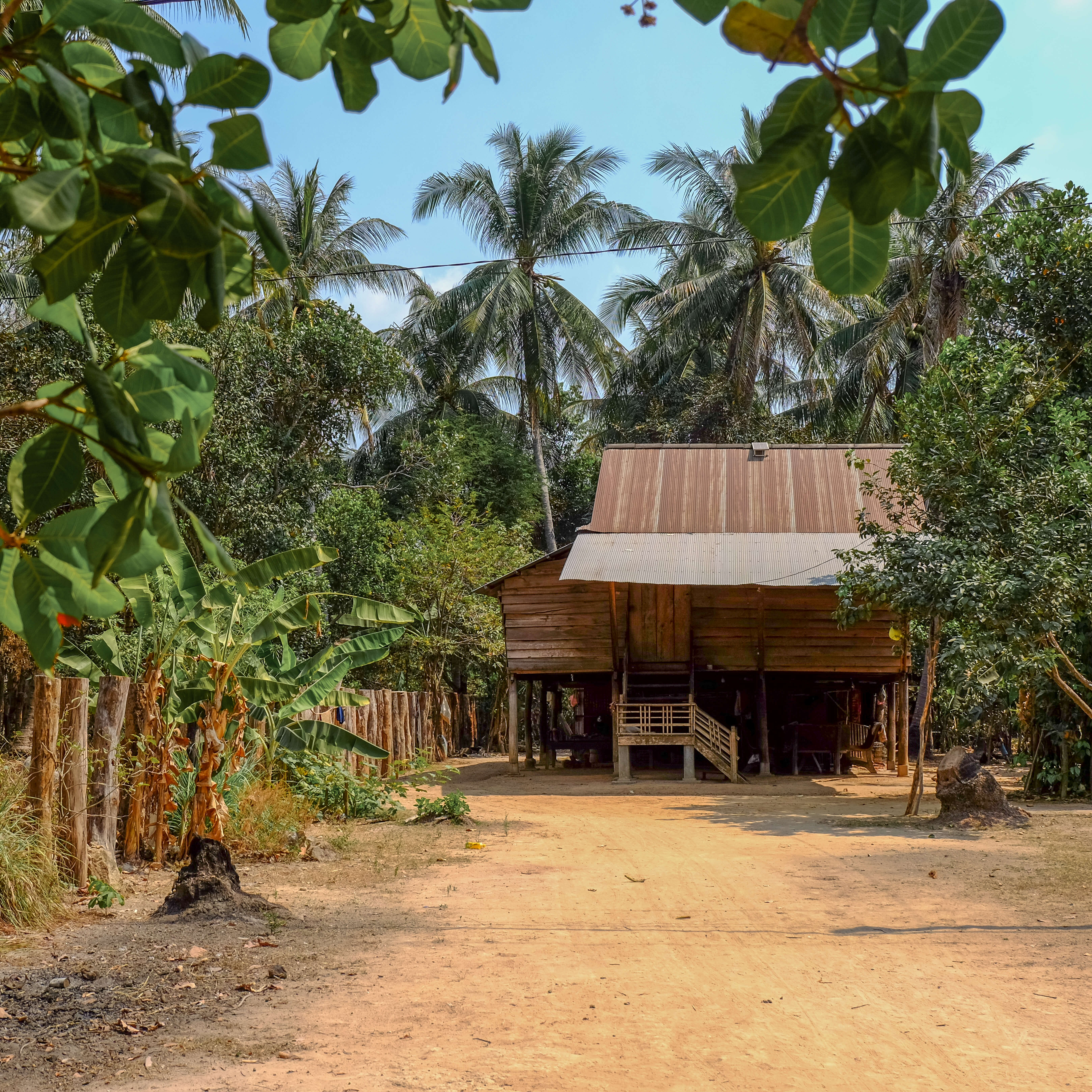

The little temple of Nak Pean is located on a small artificial island. It was believed that the water surrounding the temple had healing powers, so the temple was worshipped as an important place for the healing of sick people.
The temple is probably much more impressive during the wet season, as during the dry one (when we visited), the water was mostly dry.
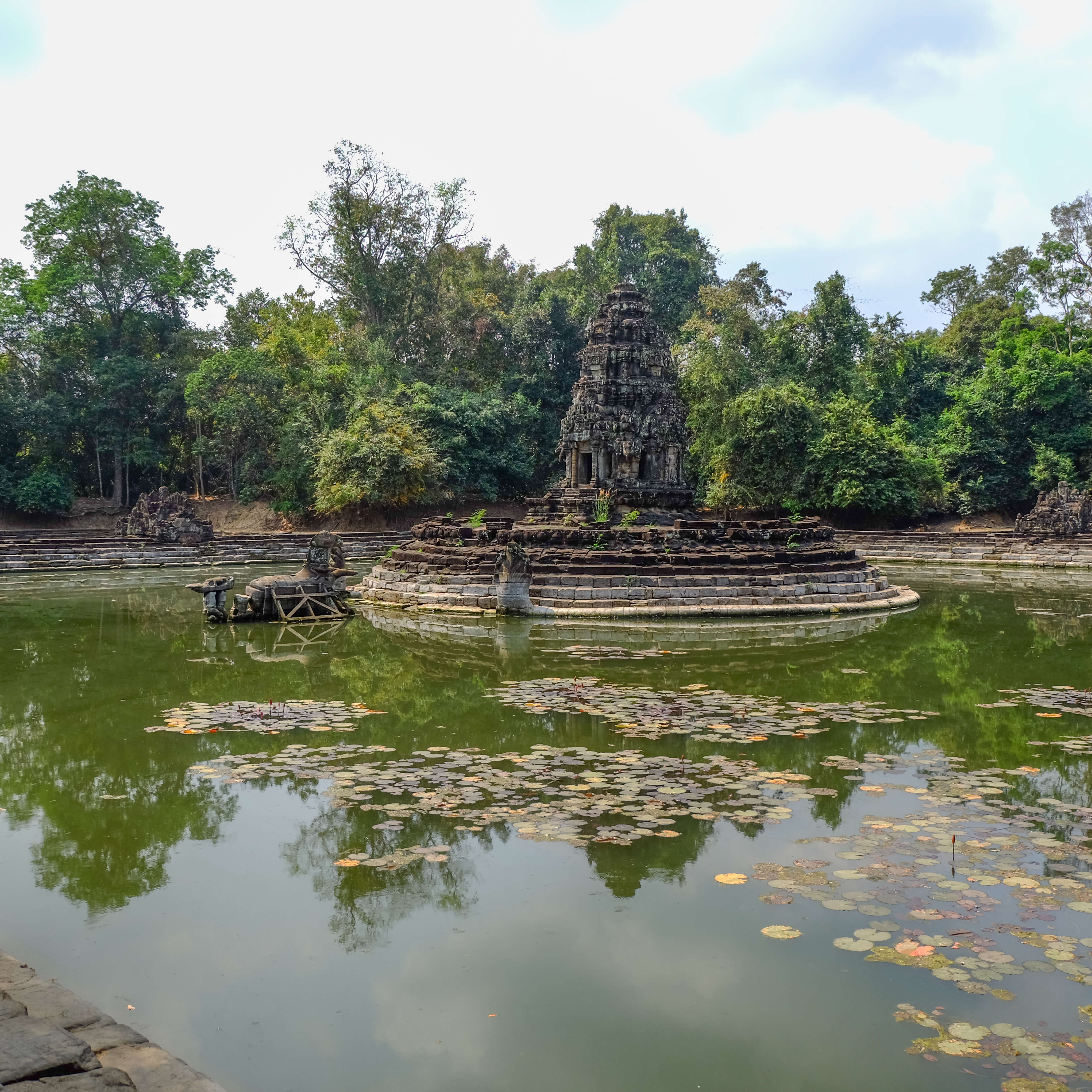
Located on the top of a hill next to the temple of Angkor Wat, Phnom Bakheng is one of the oldest temples of the entire archaeological park. Its location makes it one of the most popular temples during sunset, and a great place to admire the nearby Angkor Wat.
However, because of it’s deteriorating structural condition, only 300 visitors are allowed at a time, which can cause significant queues at the climbing entrance, especially around sunset time.
Due to the long waiting times we opted for a perimeter visit of the temple only, giving up its ascent.
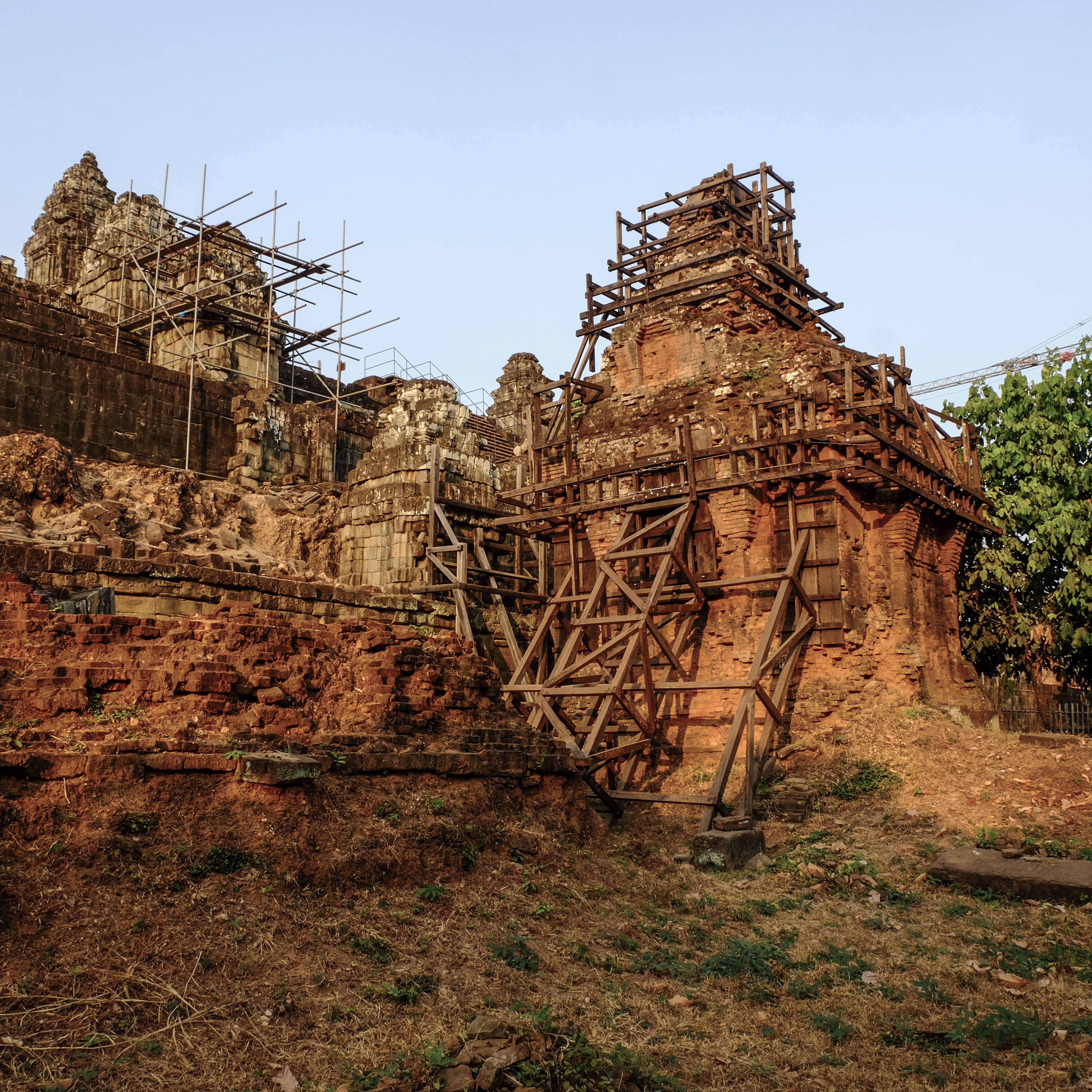

The temple of Preah Khan is one of the biggest Temples of Ankor Wat Archaeological Park, but different from the majority of the mountain-temples in the complex because its design is mostly flat.
Surrounded by a moat, Preah Khan boasts 4 entrances, each has a causeway over the moat, where visitors are greeted by statues of warriors and nagas.
The temple is characterized by four enclosures, and it combines Buddhist and Hindu sanctuaries and chapels, and many of its parts have been added at different times in different directions.
While visiting the temple, it is possible to pass through many sequences of courtyards, corridors, and small yet beautifully decorated passages, some of which are difficult to access due to the ruined state of the temple. Preah Khan is in fact mostly unrestored and in disrepair, with vegetation growing among the ruins.
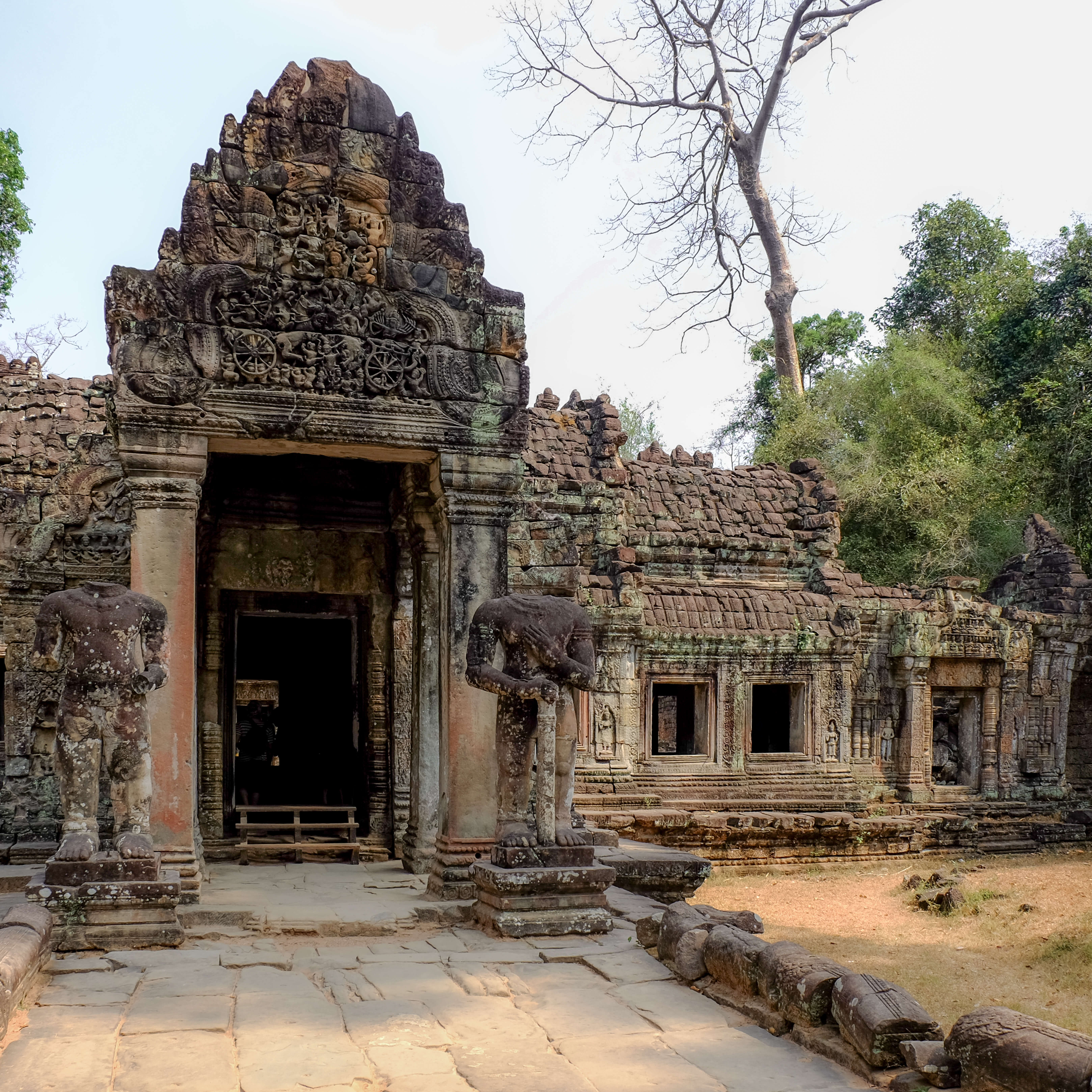

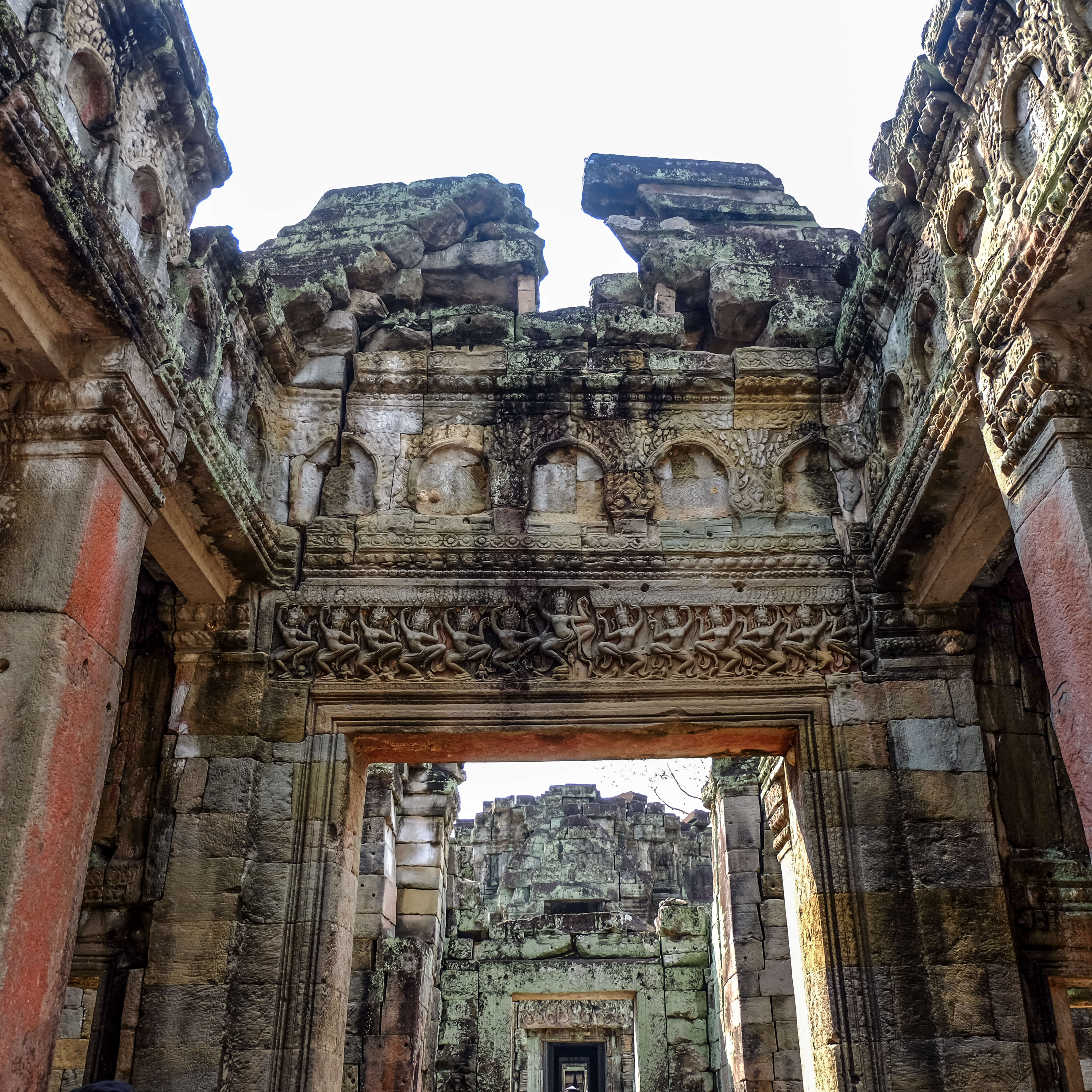
Built in the Bayon style, the small temple of Banteay Kdey is formed by two concentric galleries that enclose the central sanctuary, which is surmounted by the tower.
At the east side of the temple there is a finely decorated courtyard, especially renown for it’s dancing figures, which gives it the name: “hall of the dancing girls”.
Smaller in size and less impressive than the nearby temple of Ta Prohm, we found Banteay Kdei almost free of visitors in the middle of the day, and it was therefore very peaceful and worth a visit.
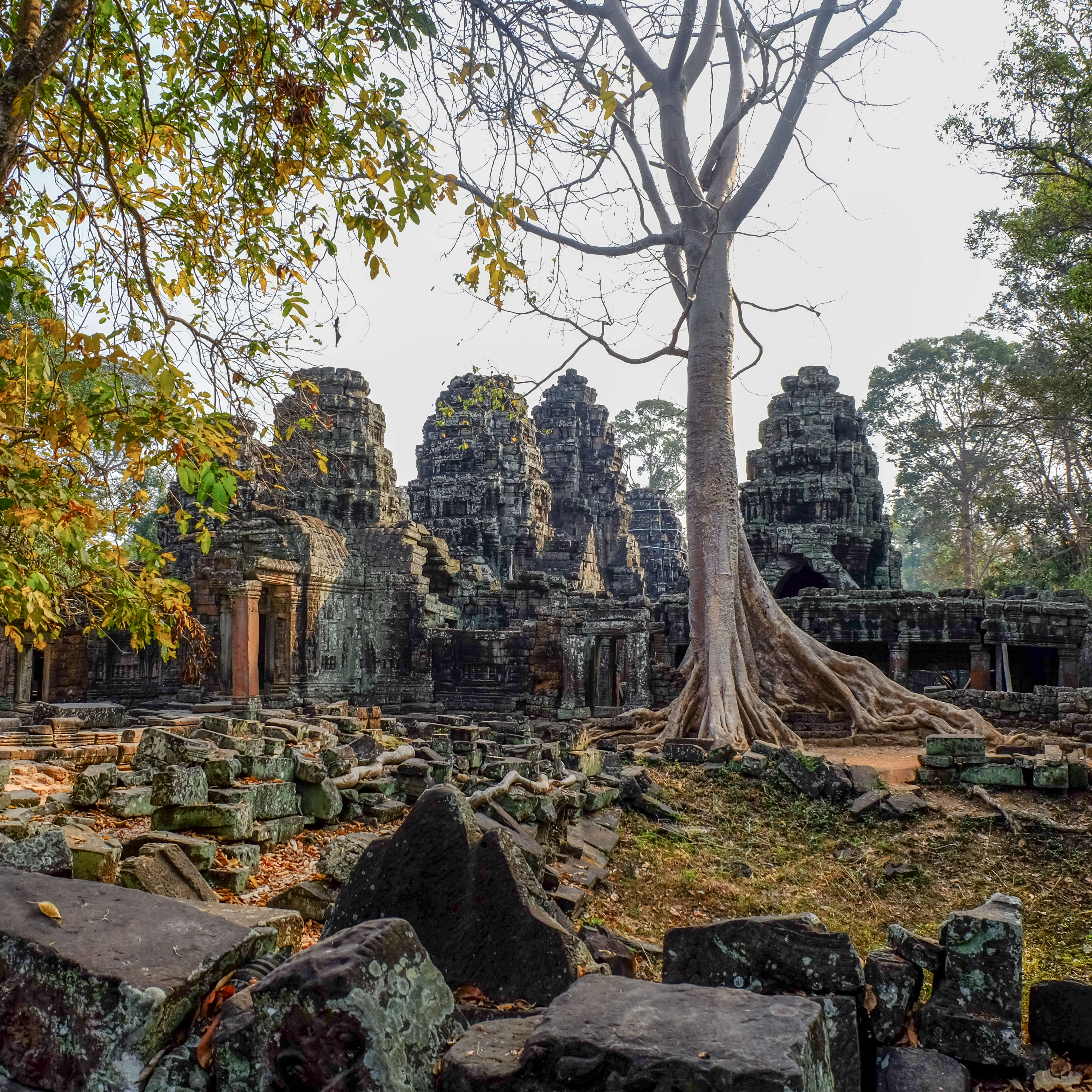
Consisting of a series of towers lining the eastern side of Angkor Thom in front of the Terrace of the Elephants, these small orange buildings don’t attract much attention from the multitude of visitors that pass every day next to them.
Located very close to the Bayon Temple, we had a nice solitary stroll to take a look inside the small towers, which are especially picturesque at sunset time, when the warm light set the color of the stone on fire.

Located right outside the Victory Gate of East Angkor Thom, we had an amazing time visiting these small Hindu temples. Collecting a few visitors during the peak hours, we found ourselves alone at sunset time, being gifted with the privilege to have an Angkorian Temple just for us.
Though really small compared to all the main temples in Angkor Wat, Thommanon and Chau Say Tevoda display beautiful decorations and are especially charming in the warm light of the late afternoon.

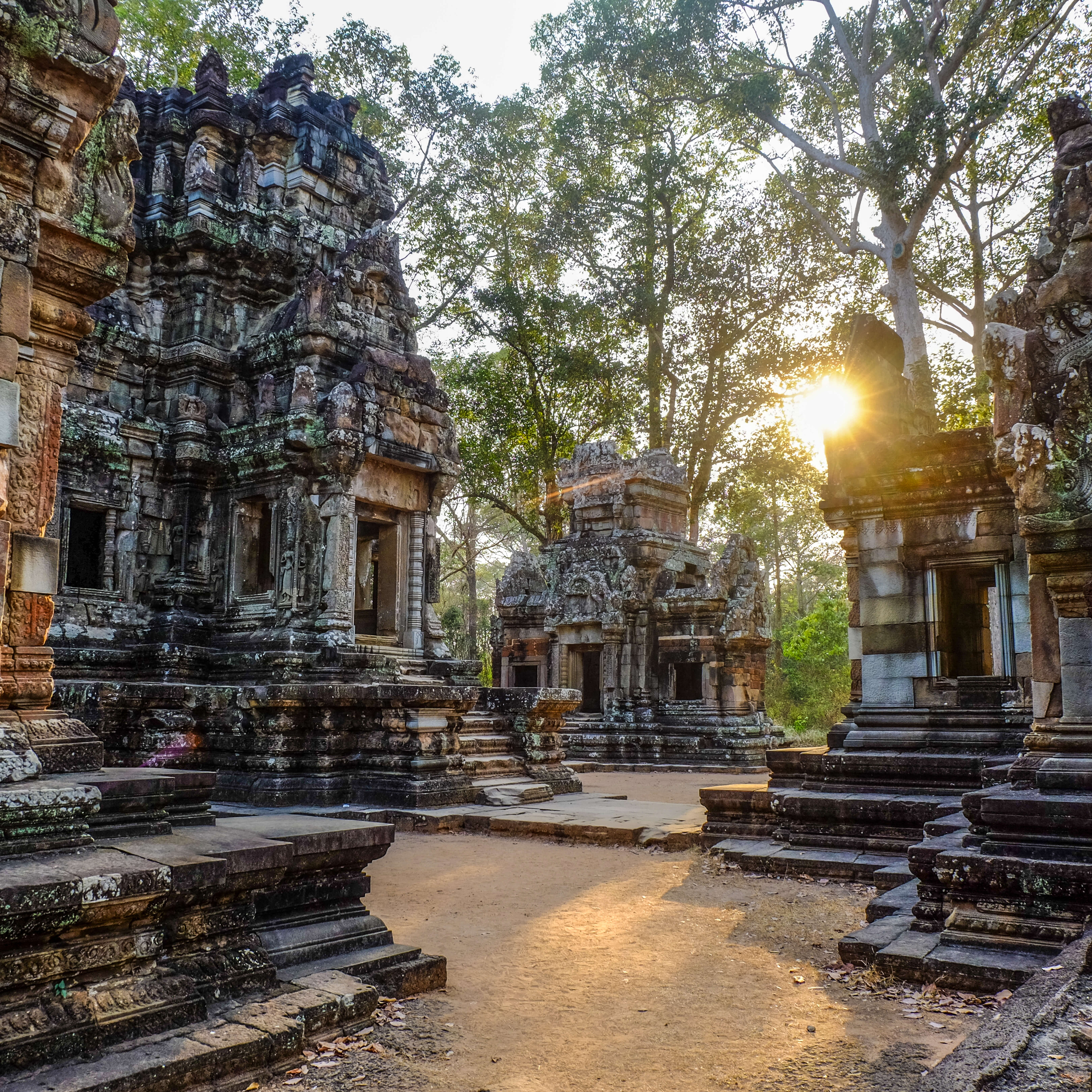
Built in laterite and red brick, Pre Rup is a mountain- temple believed to be used for funeral and crematory functions.
The temple has the shape of a three tiered pyramid with steep staircases and several small sanctuaries containing Lingas (representations of Shiva). At the center of each side, there is a stairway guarded by lions that leads to the top platform, where the 5 towers typical of the mountain temples are located.
Because of its pyramid shape and position, Pre Rup is open from 5 am to 7 pm, allowing visitors to enjoy both sunrise and sunset from the top of the “mountain.”
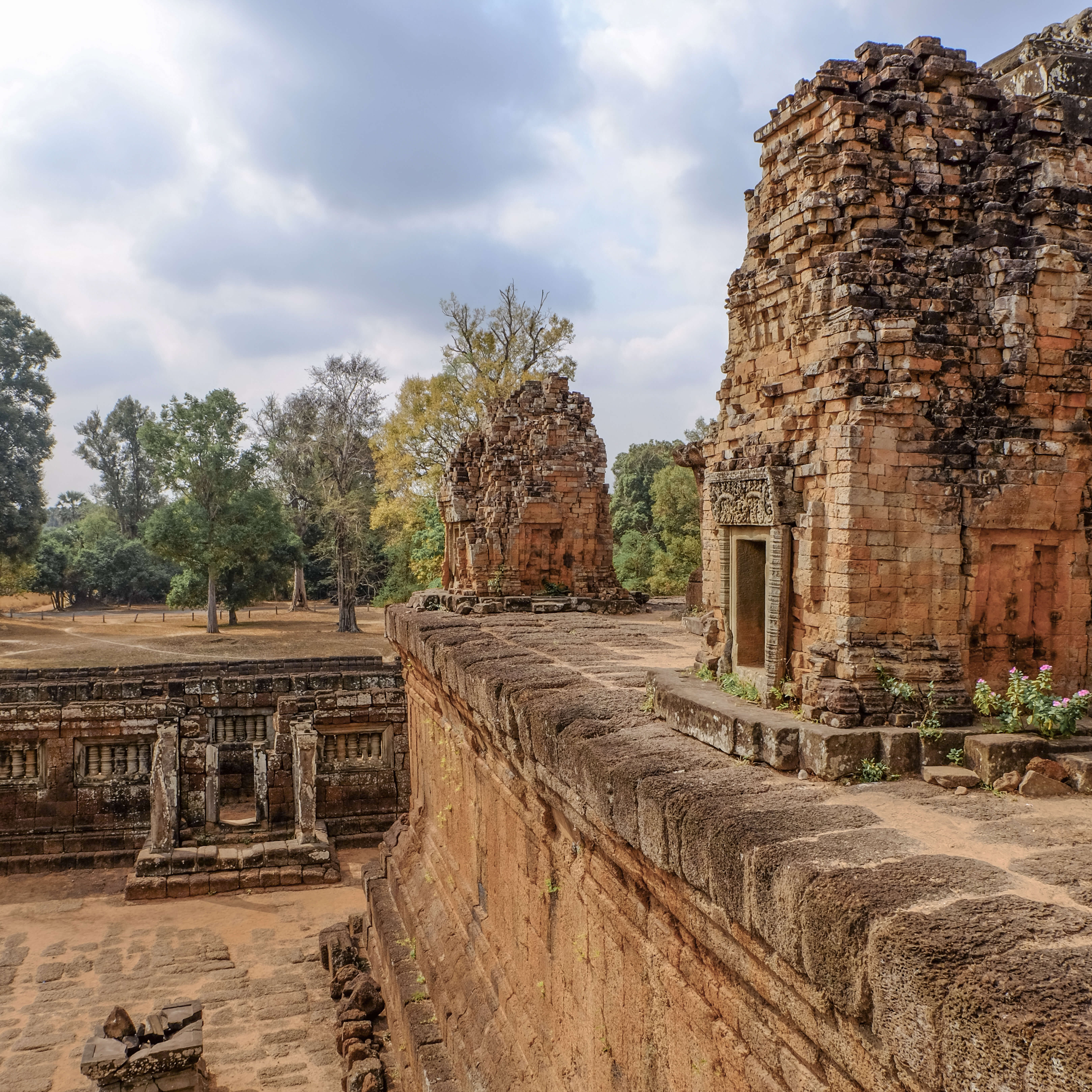
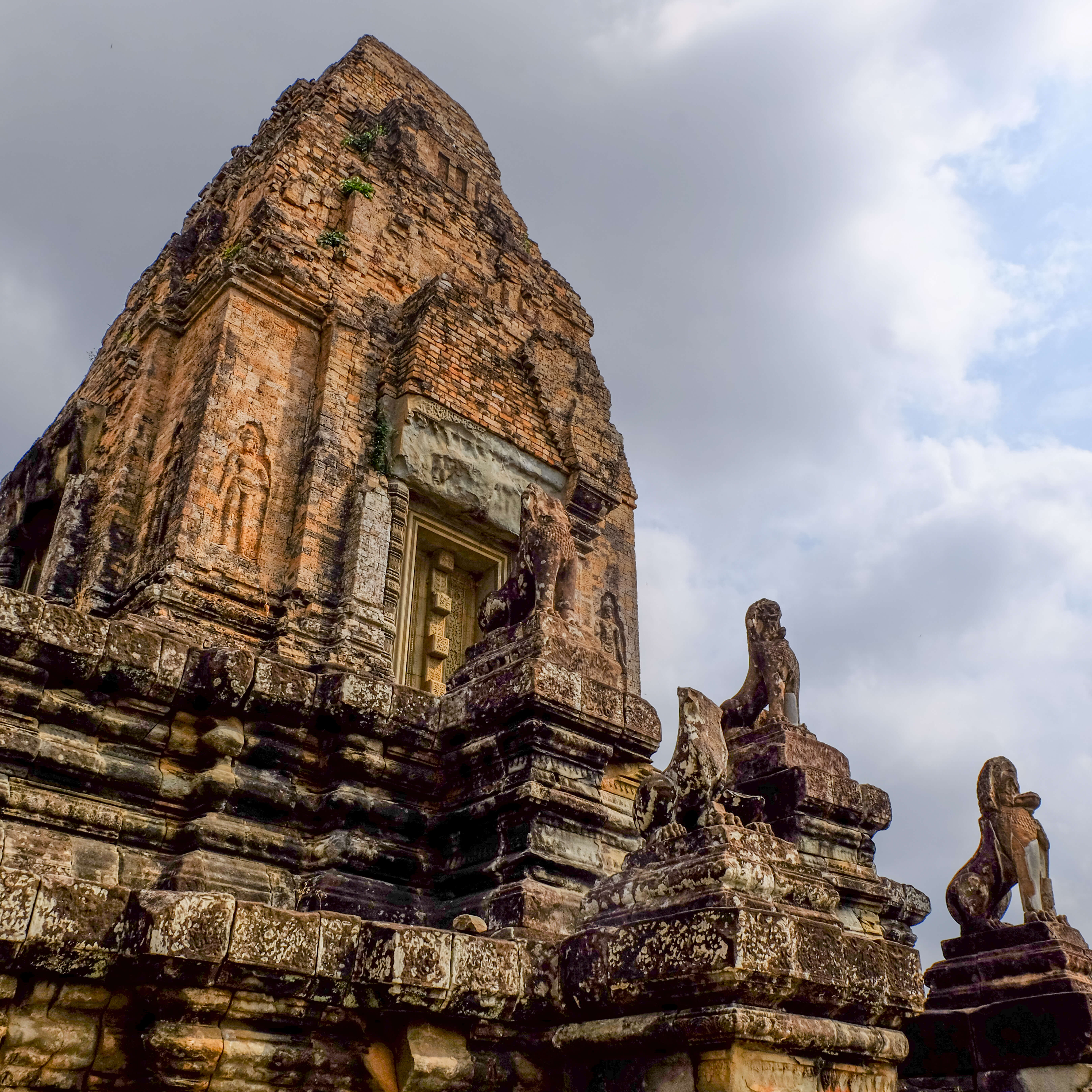
The temple of Ta Keo is a mountain temple dedicated to Shiva, whose pyramidal shape consists of 5 steps, on top of which are 5 sanctuary towers.
Massive and almost devoid of decorations, the temple has come to us unfinished. Its construction was in fact stopped for unknown reasons, probably due to the death of King Jayavarman V, who had commissioned its construction.

Lined up with Pre Rup to the south, and with the Victory Gate of Angkor Thom to the west, the Temple-mountain of East Mebon stands on Baray, a huge artificial lake that has now dried up. In fact, the temple used to stand on an island and was accessible only by boat.
The site consists of a pyramidal structure with three steps, with 8 brick towers at the entrances and the typical 5 towers on the highest step.
One of the most photographed features of East Mebon are the statues of elephants, placed at the corners of the enclosures.
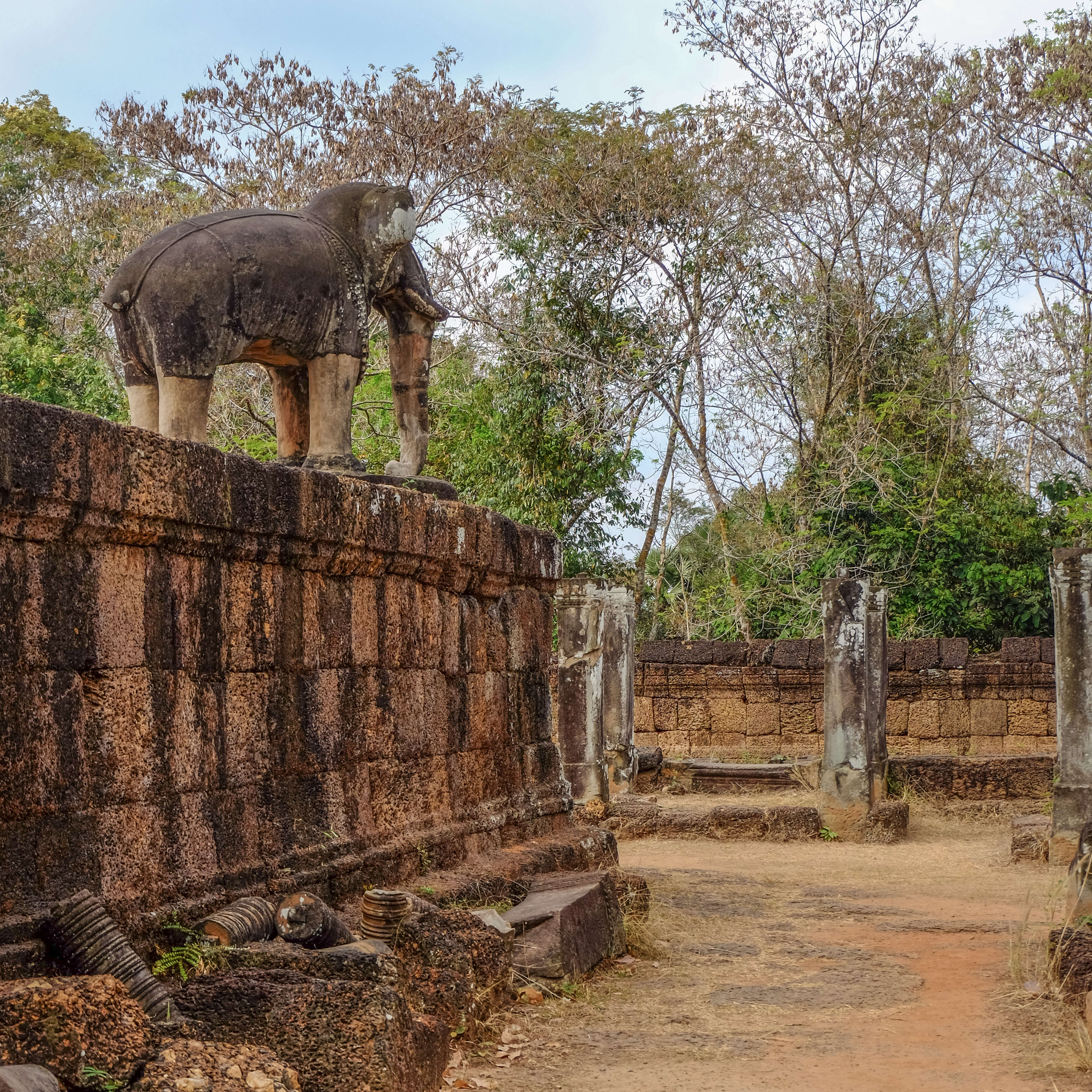
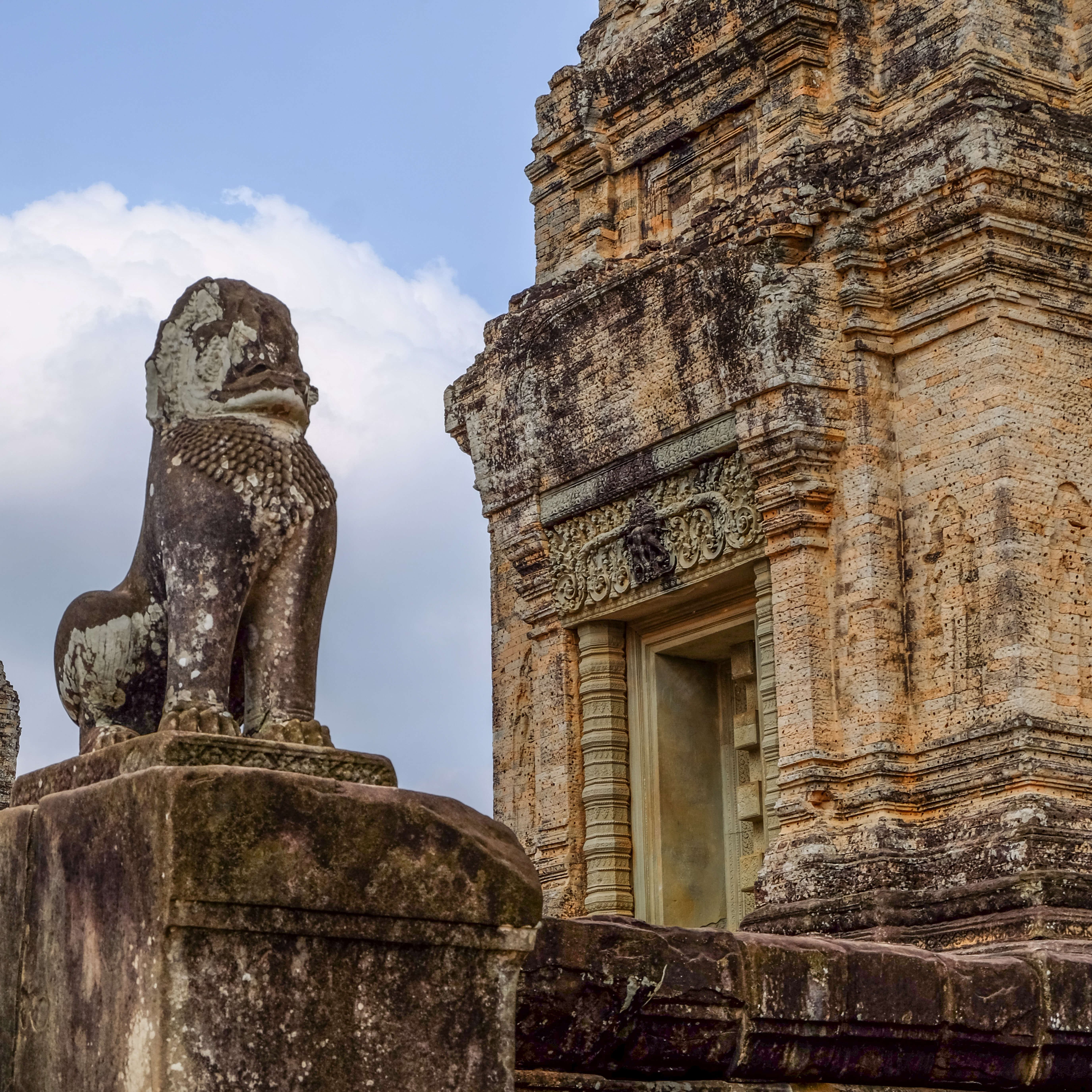
IF YOU FOUND THIS POST INTERESTING AND INSPIRING, HELP ME TO SHARE IT WITH OTHER TRAVELERS!

More from Cambodia
stay tuned !
search for a destination
latest travel itineraries
latest Cambodia articles
Text and pictures by
Architecture on the Road ©
Architecture on the Road
All rights reserved
All photographs on this site were taken and are owned by me (unless credited otherwise).
If you would like to use some of these photos for editorial or commercial purposes, many of these are available on Shutterstock (click the link below). Otherwise, please contact me on Instagram, Facebook, or by email.
Do not use my pictures without my written consent. Thank you!

